#goddess mahalakshmi face
Explore tagged Tumblr posts
Text
𝐃𝐈𝐕𝐘𝐀 𝐀𝐑𝐀𝐍𝐘𝐀
— Dwarkadhish x Dwarakeshwari

��� SYNOPSIS : When Krishna can't see his priya frowning in sadness, so, he comes up with a way to cheer her up.
🦚 KAMAL'S NOTE : This is just a work of fiction and nothing to do with the actual events. I just wanted to write something for Maa Rukmini and Krishna since there is not much. Hopefully I didn't cross the line. This fic made me hate the word 'hand' to be honest 😮💨. The devider is from this post.
Kamalnayan = Lotus like eyes, Sri = Mahalakshmi/Rukmini, Nupur = Anklet, Aradhya = Adored one, Arya = Honorable one.

Sweet wind blew past the raven locks, forcing them to dance on the rhythm with it. Dwarakeshwari, Rukmini Maharani, sat on the edge of the majestic water fountain. Her hand playing with the rippling cold water. The full moon shone brightly in the night's sky. The reflection of the moon in the water made Rukmini appear glowing.
Everything happened so suddenly. One day, she was writing a letter to Kanha to come and save her and the next she is now married to the said Manohari. Few days ago she came to Dwarka with her husband. People here are loving and welcoming to her but Rukmini could not help but miss her father and brothers.
Since day one she was their beloved princess but everything changed when Rukmi decided to prioritise his political friends and hate towards Krishna over her. Going against Rukmini, he rejected Krishna when he asked for her hand in marriage and then he fixed her marriage to that demon, Shishupal. Still, Rukmini loved her brother and wanted the best for them.
"Can't sleep?"
A sweet voice broke the silence of the night. Her hand stopped it's action. Rukmini heard quite footsteps advancing towards her as her heartbeat sped up. Even after loving him for years and being married to hi, Rukmini couldn't help but blush whenever he was around her.
Krishna walked up to Rukmini and sat right behind her. Their eyes met through the waters reflection but Rukmini averted her eyes away as a feeling of shyness took over, making Krishna chuckle. His wife, his Sri, can look into others eyes and put them in their places but she can't even look her Shyam. Oh! How much he yearns to see those beautiful kamalnayan.
"Could not sleep?" Krishna asked again, this time even more softer.
Rukmini nodded her head, giving him a quiet 'hum'. Krishna dipped his hand in water. Taking her hand in his, Krishna swayed them, feeling water pass through their fingers.
"So, what is bothering my beloved?"
Rukmini remained silent for a moment before speaking, "I was thinking about my people back home."
"Is that so?" Krishna wishpered, "Do you regret marrying me and coming he—"
Before he could finish, Rukmini had turned around and slammed her hand over his mouth, "What are you saying Madhav? I can never."
Rukmini felt his lips curling up into a smile against her palm. Krishna held her hand by his both hands and brought them down. But instead of letting go, Krishna clutches it even firmer.
"You are finally looking at me."
Rukmini gasped at the realisation and all the heat raised up her cheeks. As she quickly looked, Krishna took her chin between two fingers and made her face him again. Rukmini kept her head down.
Hay Bhagwan! My shy wife. Madhav thought to himself.
"Would you like to go somewhere......With me?" Krishna asked.
Rukmini nodded her head without any hesitation. Krishna stood up and held out a hand for her, "Sri?"
Rukmini placed her hand in and got up. Then Krishna started leading them out of the golden palace. They walked for at least 60 vighaṭi but neither of them seemed to mind. By day Krishna is mostly busy with work and Rukmini also has to play the mother goddess she is.
They don't get much time to spend together other than the night. They walked through the furnished road, hand in hand, under the starry night. At the end of the city was a forest. Krishna led her into it.
Moonlight failed to enter through the cover of tall tree branches. As the forest went darker, Rukmini, unknowingly, brought herself closer to Krishna. Though Krishna saw that, he didn't say anything because seeing how shy his Sri is, she might pull away.
"How far is the place, Madhav?" Rukmini asked when the road seemed to be endless. They couldn't stay out long. As the king and queen of Dwarka, work was already on their shoulders.
"Just a little more Sri." Krishna whispered, giving her hand a firm squeeze.
They walked a little more when Krishna suddenly stopped. Rukmini looked at him confused. Krishna released her hand and held up the jewelled flute. As Rukmini held the flute with care, Krishna went behind her and palmed over her eyes.
"Ma-Madhav?"
"Just a little more to go." Krishna whispered in her ear.
Rukmini trusted and started forwarding. Losing the ability to see, her other senses became stronger. The forest was silent. The sweet sound of their nupur chiming echoed through the silent woodland accompanied by occasional hooting of owls.
Krishna came to an abrupt stop, "Ready?"
Rukmini nodded impatiently, "Yes, Madhav."
Krishna slowly removed his hands. A bright light blinded Rukmini for a moment. She blinked her eyes to adjust to the light and when she saw scenery before her all she could do was gasp in surprise.
The place was glowing compared to the rest of the dark forest. Fireflies dancing with each other. Beautiful flowers are blooming all over the place. Birds like peacocks, parrots, owls, flying like it's broad daylight. Then there is deers, red panda, horses and many more playing like friends.
"Madhav, what place is this? This looks like it is Vaikuntha."
"This place is Divya aranya. Do you like it?"
"This place is heavenly. Why didn't you bring me here earlier?" Rukmini breathed out, failing to look away.
Krishna sat on the ground with his hack leaning on a big tree. While Rukmini admired the magical forest, Krishna admired his ārādhya. Her eyes sparkled like gold, taking in everything. When she was done she came and sat beside Madhav.
"How did this come here?" Rukmini felt like a child, seeing the world for the first time even though she herself was Devi Mahalakshmi.
"That…….is a story for another time. Just know that there was this man who created this place because he couldn't see his priya frowning in sadness." Mischievousness swimmed in his eyes.
Rukmini smiled with a knowing look. She really had completely forgotten about her previous sadness with her brother. Which gave Krishna relief. The last thing he wanted was for her to be sad. That too in his presence.
Rukmini felt a different sense of boldness as she dropped her head on his shoulder. When the sun goes up they will be pulled into the same work routine. So, Rukmini wanted to savour these moments as much as possible.
"Can we stay here a little longer?" Rukmini asked softly and he replied back, "As long as you want."
Rukmini's eyes fell on the flute in her hand, the divine flute that everyone praises.
"Arya, you have never played your flute for me, have you?"
Krishna laughed, "Every rag, every sur, every dhun that I play, is for you, my Sri. If not you, then I have no reason to even exist."
He sure is a ladies' man. Rukmini thought as her cheeks became red.
Rukmini gave him his flute back, "Play something for me, won't you, Arya?"
"Anything for you, Sri."
Krishna took the flute, placing his lips on it, he started playing the most madhur dhun she had ever heard. The aranya became more joyful, birds danced with the melody, animals became hypnotised with how enchanting it was.
And Darkeswari drifted into the dreamland with her head resting on her beloved's shoulder and hearing the madhur dhun.

© 𝐊𝐑𝐈𝐒𝐇𝐀𝐊𝐀𝐌𝐀𝐋 𝟐𝟎𝟐𝟑, 𝐀𝐋𝐋 𝐑𝐈𝐆𝐇𝐓𝐒 𝐑𝐄𝐒𝐄𝐑𝐕𝐄𝐃 — all content rights belongs to KRISHAKAMAL. Do not plagiarize any works and do not repost or translate onto any other sites.
All the rights and credits of the characters, gifs, songs and pictures used here belongs to their rightful owners.
#krishmini#—Krishakamal#kamal writes#vishnu#hindu mythology#mahabharat#hindublr#hindu gods#hindusim#hinduism#Krishna#rukmini#krishna x rukmini#dwarka#sanatan dharma#madhav#lakshmi#Lakshmi Narayan#rukmini x shyam
72 notes
·
View notes
Text
Worship Maa Kushmanda on the 4th day of Navaratri
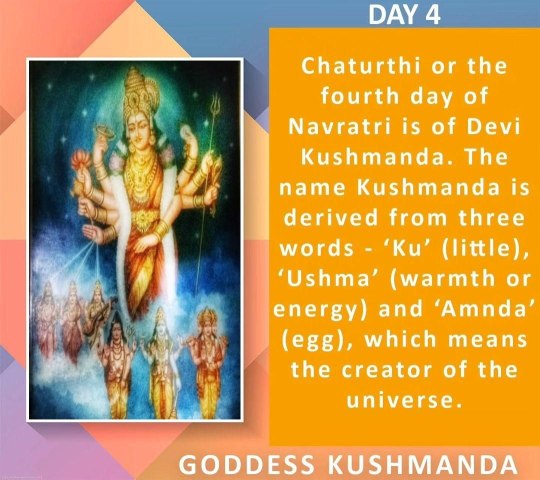
🌹 Worship Maa Kushmanda on the 4th day of Navaratri 🌹
Maa Kushmanda, the fourth Avatar of Goddess Durga, is worhipped on the 4th day of Navratri. Her name means the cosmic egg' and she is considered the creator of the universe. As per the Hindu mythology, Lord Vishnu was able to start creating the universe when Maa Kushmanda smiled like a flower which blossomed with a bud. She created the world from nothing, at the time when there was eternal darkness al around. This Swarup of Maa Durga is the source of all. Since she created the universe, she is called Adiswarup and Adishakti.
She has eights hands in which she holds Kamandul,bow, arrow, a jar of nectar (Amrit),discus, mace and a lotus, and in one hand she holds a rosary which blesses her devotees with the Ashtasiddhis and Navniddhis. She is also known as Ashtabhuja.She has a radiant face and golden body complexion. Maa resides in the core of the Sun and thus controls the Surya Lok.
Maa Kushmanda represents Anahata Chakra in spiritual practice. The divine blessings of Maa Kushmanda helps you improve your health and wealth. She removes all the hurdles and troubles from your life and enables you to get rid of all sorts sorrows in life. Maa brings light into darkness and establishes harmony in your life.
🍀. Spiritual Significance :
As Kushmanda among the nine durgas , as Mahalakshmi in Shrimad Devi Bhagawatam and as Kamakhya in tantras , Devi is regarded as the very source of everything . She is regarded as universal mother simply because everything that exists is born out of her . She is the womb / source from which Shiva ( time ) , Vishnu ( space ) and Bramha ( matter ) are also born , she is the Mother of all gods.
Kushmanda means from whose ushma / self energy , the Bramhanda ( universe ) is born . She is the mother Goddess to everything that is animate and inanimate . Creations have born out of her and goes back to her . She is the beginning and she is the end of cosmos .
Devi is consciousness and bliss incarnate as Saguna which is worshiped as Kamakhya , Mahalakshmi , Lalita , Kalika and other Vidya forms of her , and also she is formless , unknown or unseen as Nirguna parabramha . In form and as formless both ways she exists . When she's in a form she becomes the mother and creates life and universes , when she becomes formless she devours everything back within herself .
Goddess is regarded as the supreme Godhead in Hindu spirituality , almost every scripture speaks in volumes of her being the very source of universe . She is the Hiraṇyagarbha from which all life is born . In medieval times when their was a rise of male deity centric traditions in Hinduism such as shaivism and Vaishnavism , their was an attempt to hide the ancient perceived science of sages and gurus who mentioned the primordial womb or Devi as the supreme source of existence .
Today in this modern world , truth can't be hided in the name of ignorance such as gender bias . The true essence and science of Sanatana Dharma must unfold.
Mantra And Other Facts :
Maa Kushmanda Dhyan:
Sura Sampoorna Kalasham Rudhira Plutameva Cha Dadhanaa Hastapadmabhyam Kushmanda Shubhadasthu Me.
Maa Kushmanda Mantra:
Om Devi Kushmandaye Namah. (Chant it 108 times).
Colour of the fourth day: Red.
Prasad of the fourth day: Malpua and Doodh Paak
Governing Planet: It is believed that Goddess Kushmanda provides direction and energy to the Sun. Hence God Sun is governed by Goddess Kushmanda.
🌹 🌹 🌹 🌹 🌹
#జ్ఞానవాహిని#Spiritual#Bhakthi#Insight#సందేశాలు#Jnanavahini#message of the day#Devi Navaratri#prasad bharadwaj
3 notes
·
View notes
Text
1 -21 Mukhi Rudraksha Indrani Mala: A Complete Guide
The 1 to 21 Mukhi Rudraksha Indrani Mala is a sacred necklace comprising Rudraksha beads, each with a specific number of faces or ‘mukhis’ ranging from one to twenty-one. Each bead is believed to embody distinct energies and blessings, offering a comprehensive spectrum of spiritual and material benefits to the wearer.

Understanding Rudraksha Beads
Rudraksha beads are seeds from the Elaeocarpus ganitrus tree, primarily found in regions like Nepal, Indonesia, and India. The term ‘Rudraksha’ combines ‘Rudra’ (a form of Lord Shiva) and ‘Aksha’ (eyes), symbolizing the tears of Lord Shiva. These beads have been revered in Hinduism and other spiritual traditions for their purported ability to influence the mind, body, and soul positively.
Significance of Each Mukhi in the Indrani Mala
1 Mukhi Rudraksha: Represents Lord Shiva. It is believed to aid in attaining supreme consciousness and spiritual enlightenment.
2 Mukhi Rudraksha: Symbolizes Ardhanarishvara, the unified form of Shiva and Shakti. It is thought to promote harmony in relationships and balance between masculine and feminine energies.
3 Mukhi Rudraksha: Associated with the fire god Agni. It is believed to help in purifying the soul and eliminating past sins.
4 Mukhi Rudraksha: Represents Lord Brahma. It is thought to enhance creativity, knowledge, and communication skills.
5 Mukhi Rudraksha: Symbolizes the five elements (earth, water, fire, air, and ether). It is believed to promote overall health and well-being.
6 Mukhi Rudraksha: Linked to Lord Kartikeya. It is thought to enhance willpower, focus, and grounding.
7 Mukhi Rudraksha: Associated with Goddess Mahalakshmi. It is believed to attract wealth, prosperity, and abundance.
8 Mukhi Rudraksha: Represents Lord Ganesha. It is thought to remove obstacles and bring success in endeavors.
9 Mukhi Rudraksha: Symbolizes Goddess Durga. It is believed to provide protection and boost energy levels.
10 Mukhi Rudraksha: Associated with Lord Vishnu. It is thought to offer protection from negative energies and evil influences.
11 Mukhi Rudraksha: Linked to Lord Hanuman. It is believed to bestow courage, strength, and adventure.
12 Mukhi Rudraksha: Represents the Sun God (Surya). It is thought to enhance leadership qualities and boost self-confidence.
13 Mukhi Rudraksha: Associated with Lord Kamadeva. It is believed to enhance charm, attraction, and fulfill desires.
14 Mukhi Rudraksha: Symbolizes Lord Shiva in his Rudra form. It is thought to provide protection and improve decision-making abilities.
15 Mukhi Rudraksha: Linked to Pashupatinath. It is believed to enhance intuitive powers and bring spiritual growth.
16 Mukhi Rudraksha: Associated with Lord Rama. It is thought to provide victory and a sense of fulfillment.
17 Mukhi Rudraksha: Represents Lord Vishvakarma. It is believed to bring prosperity and create a nurturing environment.
18 Mukhi Rudraksha: Symbolizes Mother Earth (Bhumi). It is thought to provide stability and strength.
19 Mukhi Rudraksha: Associated with Lord Narayana. It is believed to fulfill all materialistic desires and provide immense wealth.
20 Mukhi Rudraksha: Represents Lord Brahma. It is thought to enhance knowledge and creativity.
21 Mukhi Rudraksha: Linked to Lord Kuber, the god of wealth. It is believed to attract immense prosperity and abundance.
Benefits of Wearing the Indrani Mala
Wearing the 1 to 21 Mukhi Rudraksha Indrani Mala is believed to offer a multitude of benefits:
Spiritual Growth: The mala is thought to align the wearer with higher consciousness, aiding in meditation and spiritual practices
Mental Clarity: It is believed to enhance focus, memory, and decision-making abilities.
Emotional Balance: The mala is thought to promote inner peace, reduce stress, and balance emotions.
Physical Well-being: It is believed to have healing properties that can improve overall health.
Prosperity and Success: The mala is thought to attract wealth, success, and remove obstacles in personal and professional life.
Wearing and Caring for the Indrani Mala
Proper wearing and maintenance of the 1 to 21 Mukhi Rudraksha Indrani Mala are essential to harness its full potential.
Purification and Energization
Before adorning the mala, it’s recommended to purify and energize it:
Cleansing: Gently wash the Rudraksha beads with unboiled milk mixed with a pinch of sugar or honey. Rinse them with clean water while chanting “Om Namah Shivaya” to infuse positive vibrations.
Energization: Place the cleansed mala at the base of a Shiva Lingam and perform an Abhishek (ritualistic bath) by pouring milk mixed with honey or sugar over the Lingam. This act is believed to sanctify the beads with divine energy.
Wearing Guidelines
Threading: Use a silk thread to string the beads, as it’s considered the best natural option due to its quality and strength. Alternatively, thin gold or silver chains can be used, ensuring that the beads are not damaged during the process.
Placement: The mala should be worn so that it touches the skin, facilitating the flow of energy.
Occasions: It’s advisable to wear the mala during meditation, prayer, or spiritual gatherings to enhance its efficacy.
Visit https://rudrabliss.com/2025/03/19/1-to-21-mukhi-rudraksha-indrani-mala-power-benefits-and-guide/ to read full post
0 notes
Text
Discover the Powerful 7 Mukhi Rudraksha Benefits | Hare Krishna Mart
The 7 Mukhi Rudraksha from Hare Krishna Mart is a powerful spiritual bead with many benefits. It is believed to improve health, bring wealth, and protect from negative energies. The seven faces represent Goddess Lakshmi, helping attract prosperity and abundance, while also promoting mental clarity and peace. Wearing this Rudraksha can improve focus, boost confidence, and balance your energy. It’s perfect for those looking for spiritual growth, success, and overall well-being. Add this sacred bead to your daily routine and feel its transformative power in your life today.
Read More:
0 notes
Text
Natural 13 Mukhi Nepali Rudraksha
A unit Of Salasar Ji Gems LLP
Natural 13 Mukhi Nepali Rudraksha

₹7,500.00
Natural 13 Mukhi Nepali Rudraksha (13 faced Rudraksh) also called Trayodash Rudraksh represents Lord Indra, the King of Devas, and God of rain and thunder. It is a symbol of abundance, prosperity and happiness. This holy Rudraksh is blessed by Lord Kamdeva (God of love and attraction) and Goddess Mahalakshmi. The ruling planet is Venus which is associated with wealth and worldly possessions. With their blessings the wearer can fulfill all his desires and lead a harmonious happy life.
The benefits of 13 Mukhi Rudraksh (Terah mukhi Rudraksh) are manifold. This Rudraksh is also called “Indra Rudraksh” due to its association with Lord Indra. The blessings and protection of Indra Devta is gained by the wearer. The bead enhances the will power, confidence and the determination of the user.
Lord Kamdeva (Cupid god) blesses the wearer of 13 Mukhi Rudraksh by fulfilling all his worldly desires. The wearer is bestowed with success in love life and intimate relationships. It helps to enhance the creativity and passion inside him. The bead assists in fostering love connection, finding a suitable partner, and building a harmonious relationship. It bestows the user with the charm and attractiveness of Kamdev (Cupid god).
Terah Mukhi is blessed by Goddess Laxmiji which provides wealth, riches and prosperity to its user. By reciting the Laxmi Sukti or Mahalaxmi Strot one can achieve immeasurable profits.
Astrologically, the original Natural 13 Mukhi Nepali Rudraksha nullifies the negative effects of planet Venus and Moon.
Medicinally, this Rudraksh helps in the treatment of sexual disorders, low desire and infertility. It improves the functioning of urinary and reproductive organs. Also the bead is helpful in curing lower back pain, sciatica, and kidney related problems.
How to wear : As regards wearing the holy Rudraksh, it can be worn as a pendant around the neck or as a wrist bracelet. This can be worn in silk or cotton thread, and with a capping of gold, silver or ashtdhatu (an alloy comprising eight metals).
Method of wearing: 13 Mukhi Rudraksh is worn on any auspicious day such as Monday, Full Moon Day or a festival related to Lord Kamdev or Goddess Lakshmi. After taking a bath, clean the holy bead raw cow milk, Panchamrit (a mixture of milk, curd, honey, ghee and sugar). There after clean with Gangajal or any other holy water and put on a copper plate at the place of worship. After chanting the mantra “Om Hreem Namah” at least 108 times, wear the Rudraksha.
Administrators, Actors, Politicians, Leaders and Stage Artists are advised to wear this Rudraksh to attain success in their fields. Since Lord Indra is called the King of gods, the wearer is blessed by all other gods as well.
13 Mukhi Rudraksha (Nepali),
What is the benefits of 13 Mukhi Nepali Rudraksha?
Who should wear 13 mukhi Rudraksha?
Which Rudraksha is best Nepal?
13 मुखी रुद्राक्ष किसे पहनना चाहिए?
कौन सा रुद्राक्ष सबसे अच्छा है, जावा या नेपाल?
Natural 13 Mukhi Rudraksha (Nepal Origin- Collector Size)
13 Mukhi Rudraksha benefits,
13 Mukhi Rudraksha benefits in Hindi,
13 Mukhi Rudraksha side effects,
13 Mukhi Rudraksha price in India,
13 Mukhi original Rudraksha price,
13 Mukhi Rudraksha Bracelet,
Contact Details
222, Agarwal tower, I.P.Extension, Patparganj, Delhi, 110092
Contact no : 7042891757
0 notes
Text
Benefits of Natural 1 Mukhi Rudraksha

Natural 1 Mukhi Rudraksha
1 Mukhi Rudraksha :- The wearer of a one Mukhi Rudraksha is not only blessed by Lord Shiva, but also by Goddess Mahalakshmi. This Rudraksha enhances the powers of the mind like concentration and confidence. Those who wish to escape bad habits and addictions can depend on this bead. The ruling planet of Ek Mukhi Rudraksh is the Sun who blesses the wearer with power and radiance.
In Hindu mythology, Rudraksha beads are considered sacred and have a lot of spiritual significance. A Natural 1 Mukhi Rudraksha is said to be the rarest and most powerful of all Rudraksha beads. It is the most powerful bead for meditation and dhyana purposes. It helps to control the level of energies in the human body. The wearer becomes more self-confident and independent. A person will become more solicitous and soft-hearted than before after wearing it.
How to wear it: With a pure and focused mind chant the Mantra “AUM NAMAH SHIVAYA” and/or “AUM HREEM NAMAH” 108 times. Wear the Rudraksha. The 1 Mukhi Rudraksha may be worn in silk/wool thread or capped in silver or gold. You can wear this bead around your neck or wear it as a bracelet.
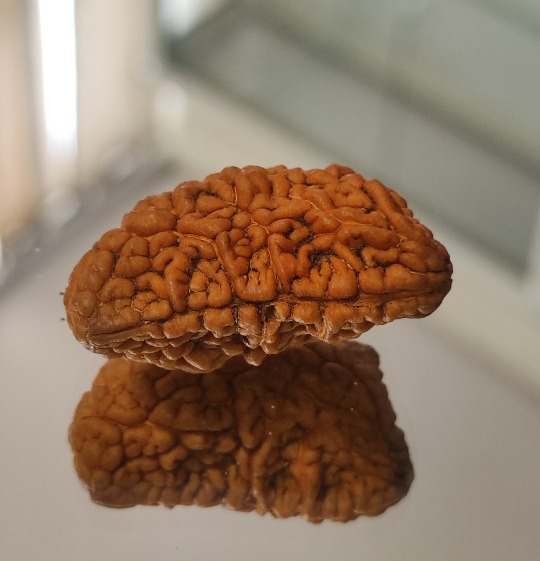
Benefits of Natural 1 Mukhi Rudraksha
1-Enhances spiritual growth: One-faced Rudraksha is believed to enhance spiritual growth and bring the wearer closer to the divine. It is said to help in attaining enlightenment and self-realization.
2-Improves concentration: The bead is said to have a positive effect on the wearer’s ability to concentrate and focus. It helps to calm the mind and improve mental clarity.
3-Brings success: Wearing a one-faced Rudraksha is believed to bring success and good fortune in all aspects of life, including business, career, and personal relationships.
4-Increases confidence: The bead is said to boost self-confidence and improve self-esteem. It helps the wearer to overcome fears and insecurities.
5-Helps with health issues: One-faced Rudraksha is believed to have a positive effect on physical health. It is said to help with ailments related to the eyes, heart, and brain.
6-Promotes inner peace: The bead is said to promote inner peace and calmness. It helps to reduce stress and anxiety and brings a sense of tranquility to the wearer.
It is important to note that while these benefits are widely believed, there is no scientific evidence to support them. Rudraksha beads should be used as a spiritual aid and not as a substitute for medical treatment or professional advice.
What is the benefit of 1 Mukhi Rudraksha?
Who can wear 1 Mukhi Rudraksha?
What is the cost of one Mukhi Rudraksha?
1 मुखी रुद्राक्ष से क्या लाभ है?
1 Mukhi Nepali Rudraksha Benefits And Price
Original One Mukhi Rudraksha Price
People also search for
1 Mukhi Rudraksha benefits
Original 1 Mukhi Rudraksha price
2 Mukhi Rudraksha
1 Mukhi Rudraksha original
1 Mukhi Rudraksha tree
1 Mukhi Rudraksha Mala
222, Agarwal tower, I.P.Extension, Patparganj, Delhi, 110092
7042891757
0 notes
Text
Intoduction to the Annapurna Upanishad, the Exploration of the Mysteries of the Queen of Foods.
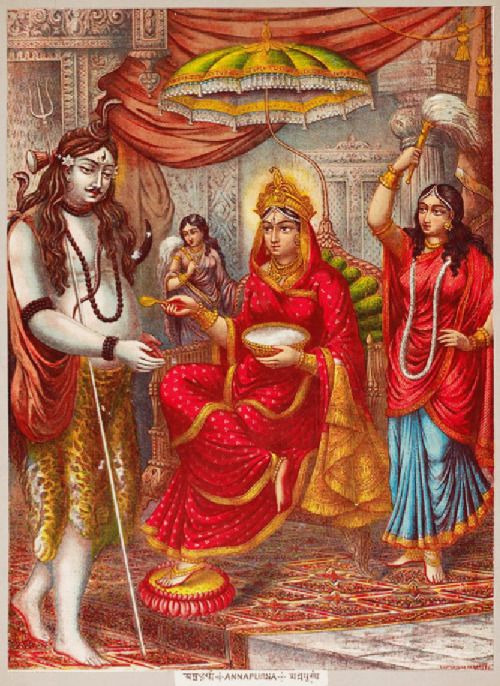
The Annapurna Upanishad was written around 3-4 CE. It is numbered 79 of 108 Upanishads and is contained in the Atharva Veda.
Annapurna means Queen of Foods. She is an emanation of gooddess Parvati, "the goddess of the mountain stream" the Ganges. She is often depicted as the partner of the god Shiva, but is also worshipped on Her Own. As the Feminine Aspect she is without rivals.
The food people eat influences their nature and vice versa. The Chhāndogya Upaniṣhad explains that the coarsest part of the food we eat passes out as feces; the subtler part becomes flesh; and the subtlest part becomes the mind (6.5.1). Again, it states: āhāra śhuddhau sattva śhuddhiḥ (7.26.2) “By eating pure food, the mind becomes pure.” The reverse is also true—people with pure minds prefer pure foods.
Although we might like to have junk, oily and spicy food, it is not good for our health and invariably causes illness. To curb the tāmasic [lazy] and rājasic [ambitious] nature of our mind and to follow a sāttvic [saintlike] regime is the only way to have healthy body and mind. “The pleasures that arise from contact with the sense objects, though appearing as enjoyable to worldly-minded people, are verily a source of misery. And such pleasures have a beginning and an end, and so the wise do not delight in them.” (Bhagavad Gita 5.22)
Therefore, we should be in constant check of what we eat as it has direct effect on our body and our mind.
Here begins the Upanishad.
Om ! O Devas, may we hear with our ears what is auspicious;
May we see with our eyes what is auspicious, O ye worthy of worship !
May we enjoy the term of life allotted by the Devas, Praising them with our body and limbs steady !
May the glorious Indra bless us !
May the all-knowing Sun bless us !
May Garuda, the thunderbolt for evil, bless us !
May Brihaspati grant us well-being !
Om ! Let there be Peace in me ! Let there be Peace in my environment ! Let there be Peace in the forces that act on me !
I-1-2. The king of Yogins, Nidagha, prostrated flat (like a rod) before Ribhu, that pre-eminent knower of Brahman. Then, rising, that ascetic respectfully said, ‘Teach me the truth about the Self; by what kind of adoration have you, Oh Brahmana, attained this state ?
I-3-4. Teach me that grand science which yields sovereignty over the empire of emancipation. ‘You have done well, Nidagha ! Listen to eternal science by the knowledge of which alone will you be liberated life. Lodged in Om that envelopes the Root of phenomena (Brahman), supporting the syllable ‘aim’,
I-5-7. ‘Eternal bliss, independent (‘hrim’), renowned, with streaming stresses (‘sauh’), the ruler of the world (‘srim’), Mahalakshmi, (at once) desire (‘klim’), fulfilment, and humanity, is the divine Annapurna. ‘I begged of Her, using the celebrated and quintessential incantation of 27 syllables, cultivated by hosts of female ascetics,
I-8. ‘Namely, aim, hrim, sauh, srim, klim, aum namo bhagavatyannapurne mamabhilashitam annam dehi Svaha. [Salutation, O divine Annapurna, vouchsafe the food I desire]: ‘Thus have I been instructed by my father. From then on have I established myself in (this) discipline, persisting in the activities of my station (in life) and have given myself up to the daily practice of this incantation.
I-9. ‘When many days passed thus, there appeared in front of me Annapurna, wide-eyed, her lotus-face beaming with a smile.
I-10. ‘Seeing her, I prostrated flat on the ground, and (then) stood up with folded hands. “Well, child, you have done well; ask of me a boon, delay not.”
I-11. Oh (Nidagha), best of sages ! Thus hidden by the wide-eyed (deity) I spoke: ‘O Daughter of the mountain, may the truth of the Self dawn on my mind’.
I-12. Saying ‘be it so’ she vanished, then and there. Then, through the perception of the world’s variety the idea (mati) arose in me.
I-13. Delusion appears five-fold; it will be presently set forth. Due to the first delusion, Jiva and God appear to have different forms.
I-14. Due to the second, the attribute of agency dwelling in the Self appears to be real. The third (consists in) deeming the Jiva associated with the three bodies as having attachment.
I-15. The fourth takes the world-cause (God) to be mutable. The fifth delusion ascribes reality to the world as distinguished from its cause. Then, also, in the mind flashes the cessation of the five-fold delusion.
I-16. From that moment, spontaneously, my mind was assimilated to Brahman. O Nidagha, thus may you, too, secure knowledge of reality.
The Upanishad does not suggest we get into the car and drive to New Jersey in search of an Annapurna Temple and commit idolatry. All Hindus know the gods are emblems of the process of the discovery of the Self. Annapurna the Queen of Foods is an aspect of the Supreme Being that helps us become secure in the teachings of the guru and the scriptures in the discovery of the ultimate truth of existence.
Shruti, the "spiritual narrator" of the text says, "yes, man can become an Agent of the Supreme Abode if his appetites for wisdom include "secure knowledge of the Almighty."
All the Upanishads suggest the following process for acquiring this knowledge which is called the Annapurna, "the Queen." It be used by persons of any faith.
Pray with a question about the nature of the Self, "Teach me that grand science which yields sovereignty over the empire of emancipation."
Now we know there are dipshitz out there trying to trap us in ignorance with discussions about nonsense and nonesuch. They are demoniacs and there is proof- their strife is ruining this planet.
So first, we have to realize the real purpose of religion is freedom from strife.
2. Freedom from the envelope of ignorance comes from science and knowledge.
3. The gods and goddesses vanish after they open the door of the mind to understanding. They are doors to the inner workings of all extant phenomena, they can do not much more. "Through the perception of the world’s variety the idea (mati) arose in me."
4. God, the gods, and the Self and all phenomena appear to be of different forms and natures. This "variety" is false. Due to delusion, the soul and God appear to have different forms.
5. Agency is the reason why delusion persists. Agency is the belief we can alter reality because we believe or have faith or repeat incantations but this also false. God is in charge of Himself, and is the Maker of Heaven and earth, not man.
6. Attachment to false ideas and impure desires cause the self to stray from the fold of the Self. Love, the very best food is the cure for all attachment.
7. God does not change, we do. Through meditation upon the Changeless, the self hinges upon a substratum it can depend upon for the purposes of weathering that which is subject to change.
8. The ultimate knowledge separates all causes from effects, and ascribes reality to its proper causes.
From the moment we accept the above path, secure knowledge of reality, the Annapurna, the Queen of Foods is ours for the taking. There should be no strife in the world due to religion or the partaking of knowledge from its proper authorities and sources.
Through the study of the Upanishads and faith if the Sublime Spirit explained within them, all strife should vanish, dissolved in the Truth never to surface again.
0 notes
Text
Unlocking the Mystical Powers of Rudraksha Beads: Benefits, Myths, and More
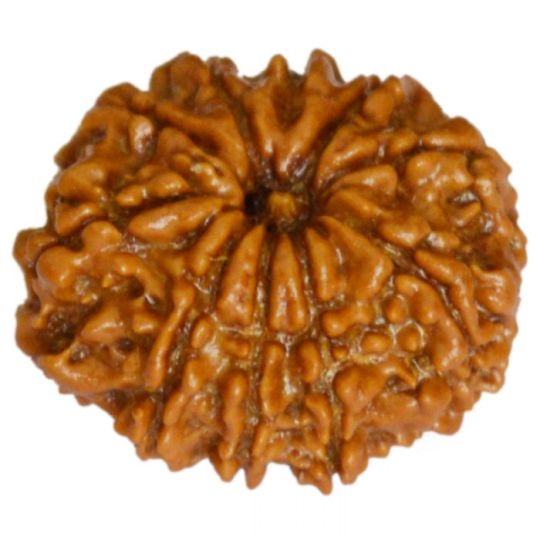
Introduction:
Rudraksha, often referred to as "Rudraksh ka ped" in Indian culture, has intrigued spiritual seekers and enthusiasts for centuries. These sacred beads, believed to possess mystical powers, are an integral part of various spiritual practices. From rudraksha beads to rudraksha malas and even rudraksha gold chains, these unique offerings of nature have gained popularity not only for their aesthetic appeal but also for their numerous perceived benefits.
In this blog, we will delve into the world of rudraksha, exploring its origins, significance, and the incredible benefits it is said to offer. Let's unravel the mysteries of these mystical beads.
The Origins of Rudraksha Beads:
Rudraksha beads are seeds obtained from the fruit of the Rudraksha tree (Elaeocarpus ganitrus), which is primarily found in the Himalayan region, Indonesia, and parts of Southeast Asia. These seeds are known for their unique appearance, characterized by multiple facets or "mukhis" on their surface. The number of mukhis on a rudraksha seed can vary, with each type believed to hold distinct properties and energies.
Significance in Hinduism and Beyond:
The word "rudraksha" is derived from two Sanskrit words, "Rudra" (a name for Lord Shiva) and "Aksha" (eye). According to Hindu mythology, Lord Shiva is said to have meditated for thousands of years with his eyes closed, and when he opened them, the tears that fell from his eyes transformed into rudraksha trees. Hence, these beads are often associated with Lord Shiva and are considered highly sacred in Hinduism.
However, the significance of rudraksha beads extends beyond Hinduism. They are also revered in Buddhism and other spiritual traditions as tools for meditation and spiritual growth. The universal appeal of rudraksha beads lies in their potential to enhance one's connection with the divine and promote inner harmony.
Types of Rudraksha Beads:
Rudraksha beads come in various types, each distinguished by the number of mukhis it possesses. Here are some of the most commonly found types:
Five Mukhi Rudraksha: This is the most common type and is believed to represent the five elements of nature. It is often used for meditation and prayer.
Four Mukhi Rudraksha: Associated with the four Vedas, this bead is said to enhance one's knowledge and intellect.
Six Mukhi Rudraksha: Linked to Lord Kartikeya, the six-faced bead is believed to boost willpower and creativity.
Seven Mukhi Rudraksha: This bead is associated with the Goddess Mahalakshmi and is thought to bring wealth and prosperity.
Eight Mukhi Rudraksha: It is linked to Lord Ganesha and is believed to remove obstacles from one's path.
Nine Mukhi Rudraksha: This bead is associated with Goddess Durga and is said to provide strength and courage.
Ten Mukhi Rudraksha: Representing Lord Krishna, it is believed to bestow divine protection and love.
Eleven Mukhi Rudraksha: Associated with Lord Hanuman, this bead is thought to enhance concentration and wisdom.
Twelve Mukhi Rudraksha: It is believed to be a symbol of Lord Surya and is associated with abundance and success.
The Benefits of Wearing Rudraksha Beads:
Now that we've explored the diverse types of Rudraksha beads, let's delve into the potential benefits of wearing them:
Spiritual Growth: Rudraksha beads are believed to aid in meditation, helping individuals achieve deeper states of consciousness and spiritual growth.
Stress Reduction: Wearing rudraksha beads close to the skin is thought to reduce stress and anxiety, promoting a sense of calm and inner peace.
Enhanced Concentration: These beads are said to improve focus and concentration, making them ideal for students and professionals.
Health Benefits: Rudraksha beads are also believed to have positive effects on physical health, including reducing blood pressure and improving overall well-being.
Protection: Many wearers believe that rudraksha beads offer protection from negative energies and malevolent forces.
Harmonizing Chakras: Each type of rudraksha is associated with specific chakras, and wearing them is believed to help balance and align these energy centers.
Manifestation: Some individuals use rudraksha beads as Rudraksh mala for manifesting their desires and intentions.
How to Choose and Care for Rudraksha Beads:
When selecting rudraksha beads, it's essential to ensure their authenticity. Here are some tips:
Buy from a reputable source: Look for trusted sellers or websites like AstroPragyan that specialize in authentic Rudraksh gold chain.
Check for certifications: Genuine rudraksha beads often come with certificates of authenticity.
Know the type: Understand the properties and benefits associated with the specific type of rudraksha bead you wish to purchase.
Caring for rudraksha beads is relatively simple:
Keep them clean and dry.Avoid exposing them to chemicals or extreme temperatures.Store them in a clean, sacred place when not in use.
Conclusion:
Rudraksha beads have been revered for centuries for their potential to facilitate spiritual growth, promote well-being, and offer protection. Whether you're drawn to their aesthetic beauty or the spiritual significance they hold, rudraksha beads can be a valuable addition to your spiritual journey. Remember to choose authentic beads from reliable sources like AstroPragyan to fully experience their benefits and mystique. Embrace the wisdom of the Rudraksh ka ped, and let its sacred beads guide you on your path to spiritual enlightenment.
1 note
·
View note
Text
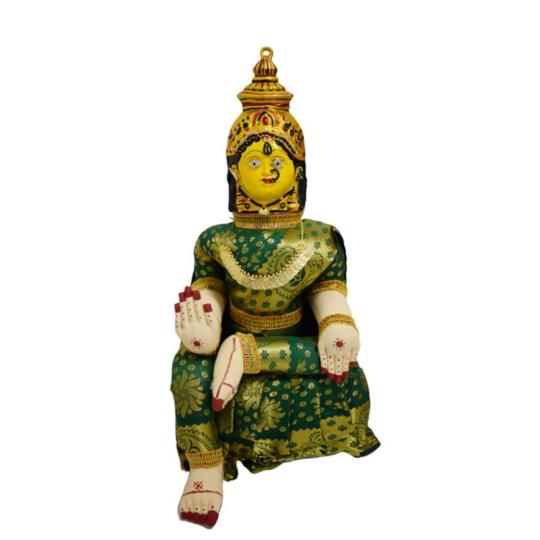
Varalakshmi Amman Idol With Green Gold Saree
Lakshmi, the goddess of prosperity is always associated with a certain grandeur. Decorating the goddess during festivities with all the workload from scratch is a challenging task. With the hope to bring forth the divine grace of the empress of wealth, we offer our premium range of completely decorated Lakshmi devi idols for varalakshmi vratha. Exquisitely draped with a grand green and gold saree and affixed with hands and legs; this idol is complete with the resplendent face of Mahalakshmi. Purchase This Varalakshmi Amman Idol With Green Gold Saree.
0 notes
Text
Original 7 mukhi nepali rudraksha with lab certified
https://www.kailasharudraksh.com/
Benefits of 7 mukhi rudraksha
Who should wear this- People of all professions and occupations can wear Suptamukhi Rudraksha to get happiness and prosperity. It is better if Ashtamukhi (Ganesha) Rudraksha is also worn along with it, although Saptamukhi in itself is very effective. In some homes it is kept on the altar of worship or in a piggy bank.People suffering from bone diseases and arthritis will find it very useful in the prevention of diseases and pains. For this benefit, if there are Nepali beads, at least five and if there are Indonesian beads, then 54+1 or 108+1 beads should be worn.Mantras to be chanted with Saptamukhi Rudraksha are:
Om Hum Namah Om Hree Namah
Om Hree Shree Clean Hundred Namah
Seven Mukhi Rudraksha
Its ruling planet is Saturn. If there is a defect caused by the planet Saturn, a person suddenly gets disease, infertility, cold, obstruction in work, depression, delay in success, chronic disease, lack, anxiety, etc. without any reason. By using Saptamukhi Rudraksh, all the above Shani born defects are removed.
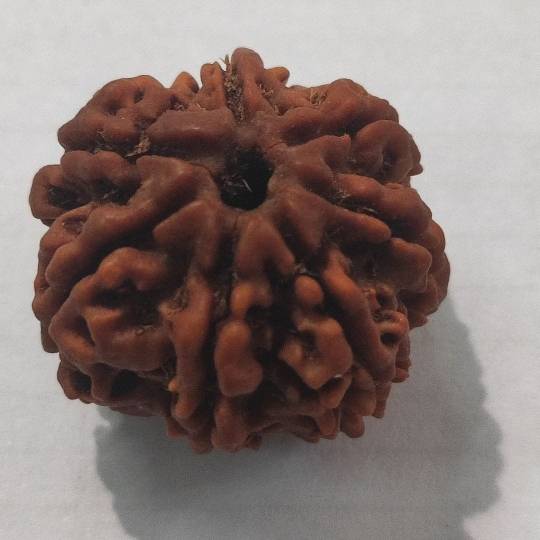
7 Mukhi Nepali Rudraksha is dedicated to the seven Matrikas, Surya, the Saptarishis, Mahesana (Kartikeya), Ananga (Kamadeva), Ananta (Basuki—the king of snakes), and the serpent king. According to public interest, above all, it is dedicated to the infinite infinite Parabrahma.According to the Brahma Purana (which describes the origin of the universe), Lord Vishnu produced a lotus from the navel as desired by Shiva. This lotus was huge, with many stalks, well organized and beautiful. Its color was yellow like Kaner. Lord Shiva created Brahma (Hiranyagarbha) from his right side and placed it in the stem of a lotus. Hiranyagarbha appeared from this lotus. The four-faced Hiranyagarbha got curious to know about himself and started roaming in the lotus stalk. But even after hundreds of celestial years he could not find out the secret of his origin. Shivji himself advised him to meditate and after 12 divine years of penance, Vishnuji appeared before him. There was a dispute between these two, then Lord Shiva appeared in the form of Jyotirlinga and said, “You both have immense power and vast knowledge, but you cannot find the beginning or the end of the universe. So call it eternal.”This meaning of infinity is revealed on applying Saptamukhi Rudraksha that it is very useful and bestows the holder with many types of powers.According to the Padmapurana, the following divine serpents reside in the seven faces of this Rudraksha: Ananta, Karkat, Pundarika, Takshak, Vashoshimban, Karoash and Shankhchud. It is concluded from this that its holder is not affected by any kind of poison. This helps in getting rid of sins like theft, adultery and drug abuse.Its wearer gets hidden wealth, gets the power to attract the attention of the person of the opposite sex and destroys the enemies.This Rudraksha being dedicated to Saptamatrika pleases Mahalakshmi. The seven divine mothers are: Brahmi, Maheshwari, Kaumari, Vaishnavi, Varahi, Indrani and Chamunda. Being blessed by many deities, this Rudraksha brings fame, wealth and progress in life and removes misfortune. The wearer gets the divine grace of Goddess Mahalakshmi.According to Jabalopanishad, Saptamukhi Rudraksha is similar to Sapta Brahmi and Saptarshi (Saptarshi originated from Manas of Brahmaji). This Rudraksha bestows good health and wealth. There are seven sages of the Saptarishis: Marichi, Atri, Angira, Pulastya, Pulah, Ritu and Vashishtha. Each Manvantara (cycle of the world) has a different Saptarishi. He is also seen in the sky as the ‘son of the stars’ and is called the Saptarishi Lok. It is said that those pious people who do evening prayers daily and chant Gayatri go to Saptarshi Lok.Saturn is the ruling planet of Saptamukhi Rudraksha. According to Matsya Purana, Shanischar is described as a man of black color in human form, who has a punishment (for punishment) in one hand, Rudraksh’s garland in the other hand. Veins are visible all over the body. He is ready to cure all the diseases of the applicant.From experience, Seven Mukhi Rudraksha is very helpful in reducing the pain of arthritis. It is helpful in all kinds of nervous pains, venereal diseases (including sterility), heart diseases, throat diseases and leukemia.
1 Mukhi Rudraksh
4 Mukhi Rudraksh
7 Mukhi Rudraksh
10 Mukhi Rudraksh
13 Mukhi Rudraksh
16 Mukhi Rudraksh
19 Mukhi Rudraksh
Ganesha Rudraksha
2 Mukhi Rudraksh
5 Mukhi Rudraksh
8 Mukhi Rudraksh
11 Mukhi Rudraksh
14 Mukhi Rudraksh
17 Mukhi Rudraksh
20 Mukhi Rudraksh
Gauri Shankar Rudraksha
3 Mukhi Rudraksh
6 Mukhi Rudraksh
9 Mukhi Rudraksh
12 Mukhi Rudraksh
15 Mukhi Rudraksh
18 Mukhi Rudraksh
21 Mukhi Rudraksh
Address-222, Agarwal tower, I.P.Extension, Patparganj, Delhi, 110092
Cont No. : 7042891757
0 notes
Text
7 Mukhi Rudraksha - The Divine Bead with Seven Faces
Rudraksha beads have been known for their divine properties and significance in Hindu mythology. The 7 Mukhi Rudraksha is a rare and powerful bead that is believed to have many spiritual and healing benefits. In this article, we will explore the 7 Mukhi Rudraksha and its significance in detail.

What is a 7 Mukhi Rudraksha?
The 7 Mukhi Rudraksha is a bead that has seven natural lines or Mukhis on its surface. It is also known as the Saat Mukhi Rudraksha and is considered to be one of the most powerful and auspicious beads among all the Rudraksha beads. The seven Mukhis on the Rudraksha represent the seven forms of Goddess Mahalakshmi, who is the goddess of wealth, prosperity, and abundance.
Benefits of 7 Mukhi Rudraksha:
Wealth and Prosperity: The 7 Mukhi Rudraksha is believed to attract wealth and prosperity. It is said to open up new opportunities for financial growth and success.
Health Benefits: The Rudraksha is believed to have healing properties and can help in curing ailments related to the liver, stomach, and pancreas.
Spiritual Benefits: The 7 Mukhi Rudraksha is known to enhance intuition and spiritual growth. It can help in developing a deeper connection with the divine and attaining higher states of consciousness.
How to wear a 7 Mukhi Rudraksha:
The Rudraksha can be worn as a necklace or bracelet. It is important to wear it on the left side of the body, close to the heart. Before wearing it, the Rudraksha should be purified with holy water and energized with mantras.
Conclusion:
The 7 Mukhi Rudraksha is a powerful and auspicious bead that is believed to have many spiritual and healing benefits. It can help in attracting wealth, promoting good health, and enhancing spiritual growth. By wearing the 7 Mukhi Rudraksha, one can experience a deeper connection with the divine and attain higher states of consciousness.
0 notes
Text
Ramam Bheemam
Sita Ramam but make it Rambheem
Madiha (Malli) is a college graduate in London who has gotten into trouble for flaming up an Indian professor's car in protest against India. She is required to pay a hefty fine or apologise for her wrongdoing. She chooses the former and heads to Pakistan to get her inheritance from her grandpa only to find him deceased. An old unopened letter addressed to a Sita Mahalakshmi is the only thing left behind for Madiha, the key to her inheritance lying in its delivery.
She goes to Adilabad Centre for Women's Education, India, in search of the name addressed on the envelope. However, everyone at the university collectively know nothing about any Sita Mahalakshmi.
Madiha, annoyed by this chicken run, decides to unravel Ram's story. They go to many a sources to learn the story.
Ram, lonely yet full of friends, was a soldier with a heart of gold. He had so much love yet no one to give it to. After a particularly attempt at reuniting the Agarta Hindus and Muslims, Ram's batallion became the focus of attention. And then the letters started pouring in: letters of a sisters who yearn to meet him, grandparents all over the nation giving them their heartfelt praises and memories to make.
But one letter stood out.
One Sita Mahalakshmi, a certain someone who laughed at him for thinking he has no one, when he'd left his bride a worried mess in the country. Hands looping with every curve of the handwriting, Ram now had a partner in his grief and his happiness. Someone to come home to in the holidays.
When he reached Hyderabad in search of his letter writer, the face that opened the door to him is not that of a goddess, but of a god.
Sita Mahalakshmi was there, but she knew nothing of the letters. Ram wanted to think he was imagining it, but her heart was tightly bound not to him, but to a beautiful Englishwoman with gems for eyes.
The god who opened the door to him in darkness was shy, confessed his name was Bheem. What his gaze had told Ram without confession was that the one in the letters was Bheem.
And so it goes... The story war wrote, the deception that gave the golden heart a gem in its crevice: from the first moment his eyes befell Bheem, he was an orphan no more.
#.....idk how and what this is#sita ramam#ramam bheemam#rambheem but series#rrr#rrr au#rambheem#sinny
36 notes
·
View notes
Text
the beauty of jyeshta 🐇🏹:
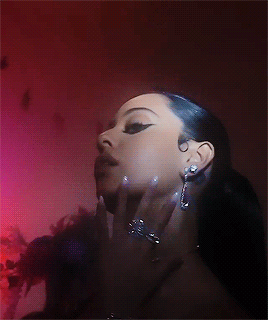
🐇 alexa demie: jyeshta surya
*TW// i do discuss a few triggering topics i.e. abuse and drugs. some of the jyeshta natives i exhibit and talk about are known for terrible behavior and scandals. i do not condone their offensive and ignorant behavior. they are simply being shown to solidify my opinions on the nature of this nakshatra*
as you read this post, please listen to this jyeshta playlist i made for the full experience: https://open.spotify.com/user/a95141rv0vjdg8lqcggilvcxm/playlist/3gzS9sXWs71yb2i9EiBhSY?si=xtP4mnRnR7ahXfN09KwiRw
🏹 they key to unearthing the energies of jyeshta lie in studying it’s associative deities. before we dive down the rabbit hole of the jyeshta nakshatra, let us understand the representative mahavidya of buddha. it is traditionally believed that the tantric goddess tripura sundari is associated with buddha. tripura sundari is also known as the goddess shodashi. the goddess shodashi is said to be the most beautiful in all three worlds. the goddess shodashi is also known as lalita and rajarajeshwari. lalita means “the one who plays” and rajarajeshwari means “queen of queens”. the tantric goddess tripura sundari is a form of mahalakshmi and, therefore, symbolizes wealth and abundance. according to tripura sundari’s dhyana mantra, her complexion radiates with the light of the rising sun. she emanates a rosy color which is representative of her joy, compassion, and illumination.
🌌 tripura sundari is depicted with four arms and holds five arrows of flowers (remember this number for later), a noose, a goad and sugarcane for the use of a bow. her holding a noose represents attachment, the goad represents repulsion, the sugarcane bow represents the mind, and the arrows are the five sense objects. in the sakta tantra, she is depicted as the supreme mother who uses the gods as her instruments of passion. with the aid of the instruments of passion, she presides over the creation, sustainability, and destruction of the universe—the three phases of life. she overlooks the layers of our shadow states, self-concealment and self-revelation, that lie in-between these three phases of life (bhoo, bhuva, and swa). self-concealment is the predisposition to actively conceal from others personal information that one perceives as distressing or negative. self-revelation revelation of one's own thoughts, feelings, and attitudes especially without deliberate intent.
🔥tripura sundari represents the state of awareness that is called “sadasivatattva”. this state of sadasivatattva is said to be based on the belief that “i am this” (aham idam). that, as we evolve through our cosmic destinies, we have an outward flow of consciousness, or pravritti. spiritual practice reverses our state of physical consciousness and cause us to revert to our true being. the action of coming back to our origin and finding attainment within, is a theme of jyeshta’s scorpio rashi itself, the sign of realization. it is the divine understanding that our experiences in this universe lie within the unity of consciousness itself.
🌳many believe that tripura sundari is the beauty that precedes the three worlds. that she is divinity in its infinite meanings, embodying the different aspects of the phenomenal world. tripura sundari is the beauty that we see in the world around us. she is the beauty we find in everywhere we look. modeling the captivating beauty of tripura sundari, jyeshtas naturally are externally perceived as beautiful beings who, solely with their appearances, draw the collective desires of hearts deep within. this is the essence of jyeshta’s features. they enshroud you with an abundance of beauty and over-stimulate your senses to near exhaustion. because jyeshta is symbolized by the jewel or earrings, they adorn their features with jewels and sparkling products to appear otherworldly. most notably, jyeshta natives seem to pay great attention to the forehead, neck, skin, and tongue (as buddha is said to rule these facial features). jyeshtas love to particularly adorn themselves in gold chains (i.e. jyeshta native nicki minaj and her extensive gold chain collection). remember that scorpio is co-ruled by ketu, which is remedied by brihaspati (who is remedied by gold). so the adornment of gold will be very prevalent and calming to these natives.

🐇 fka twigs: jyeshta chandra
👅another interesting characteristic of jyeshta is tongue piercings. because buddha rules the tongue and scorpio rules the blood, we see these natives naturally have quite a great deal of emphasis in their tongue area. they are inclined to/consider piercing their tongues. some examples of this are, willow smith (jyeshta shukra atmakaraka) who infamously got a tongue piercing at eleven-years-old. christina aguilera (jyeshta buddha atmakaraka) had a tongue piercing during her most notably “promiscuous” time frame in her career (aka her “dirrty” years). in the movie “thirteen”, evan rachel wood (jyeshta shani 1H) plays a young girl who gets her tongue pierced as a sign of rebellion. one thing you will notice about these jyeshta natives is that they are always under scrutiny for the changes they make to their body. however, the vimshottari buddha-ruled nakshatras embrace rebellion in the gandanta knot of deadly restriction. after all, mercury was named “the trickster” himself. this correlates back to the trickster archetype of poking out your tongue to make fun of another person. jyeshta natives most frequently pierce their tongues as a clap back to societal standards or parental authority. in this sense, they are quite literally sticking out their tongue for the purpose of mockery. these natives also prefer sticking out their tongues in photography. examine the common photos of jyeshta natives like princess nokia, nicki minaj, and rosalía (jyeshta lagna). you will notice they prefer to playfully stick out their tongue when around others. in the bible, it states “death and life are in the power of the tongue” (proverbs 18:21). meaning the tongue can either be used as a weapon to harm and destroy others or as a tool to build and heal. this is the common unraveling of jyeshta...
♏️ jyeshta lies in the final portion of scorpio. scorpio’s ruling planet is kuja, the mahavidya associated with kuja is bagalamukhi. bagalamukhi is commonly referred to as “the goddess who seizes the tongue”. once, a demon named madan undertook austerities and won the boon of vak siddhi. anything the demon said came to be true. the demon abused this power and killed many people. the gods were enraged by the demon’s wrongdoings, so they began to worship bagalamukhi to invoke her help. baglamukhi stopped the demon by taking hold of his tongue, which was the source of all mischief, and silenced his words. however, she did not kill the demon, because he asked to be worshipped with her and she agreed. this is why the demon is depicted with her. she is repeatedly portrayed with holding the demon’s tongue with a club in her other hand. by stopping the demon's tamasic tongue, she exercised her power over speech and her power to freeze, stun, or paralyze others.
🔪 bagalamukhi is also associated with magical powers, which can sometimes be referred to as siddhis, "accomplishments" or "perfections." among her epithets in her hymn of a thousand names are she who gives the eight siddhis. the invocation written around the edge of an amulet containing her yantra in the tantrasara states: "o bagalamukhi, please arrest the speech of wicked people, paralyze their faces, fix their tongues and destroy their intellect."
⚫️while jyeshtas are fond of displaying and emphasizing their tongues from a physical standpoint, this emphasis does not stop here. as you may have noticed, most of the jyeshtas featured in this thread have gotten into some serious scandals and allegations. for example, jyeshta natives like nicki minaj who married a s*xual abuser/predator, tyra banks (jyeshta surya) and her many blackface scandals, sabrina claudio who has said many offensive racial slurs, brigitte bardot who was known to be heavily racist and abusive to her child, naomi campbell who has been linked to epstein, etc.. their interviews and words are often misconstrued and taken to the extreme, as the public takes every word of their’s as the truth, much like madan (who had the power to speak things into existence). because every word these natives say is treated as the truth, they become either hindered or freed by this power. jyeshta’s have the ability to thrive in the dark abyss of scorpio and yield their words to sway the minds of others.
💎we see the public grasping jyeshtas by the tongue, much like the tantric goddess baglamukhi, and holding on to every word they say. valuing the belief that the powers of life and death lie within the words we speak. once the dark abyss consumes a jyeshta native and they no longer rely on the glamour of the tongue, we truly see how flawed and sorrowful their lives can be (despite their abundant beauty).
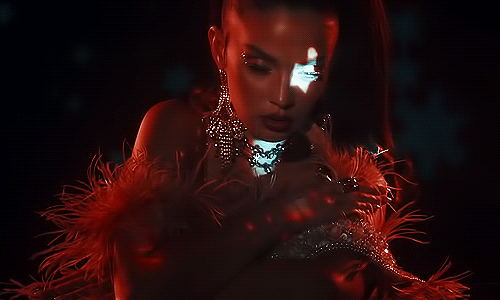
🐇 sabrina claudio: jyeshta chandra
💔 jyeshta means “the eldest" or "the elder". she is the goddess of inauspicious happenings and misfortune. as her sanskrit name suggests, she is regarded as the elder sister of lakshmi (the goddess of good fortune and beauty). unfortunately, jyeshta is frequently associated with sinning, laziness, poverty, sorrow, ugliness and the crow. because of her inauspiciousness and crow symbolism, she is sometimes associated with alakshmi. due to jyeshta representing the bad wife and lakshmi representing the good wife, jyeshta is often worshiped for women who wish to keep her away from their homes, as she is said to cause marital disturbances.
🌊 most astrologers agree that jyestha's birth took place during the churning of the cosmic ocean. she was said to be born when the poison, halala, flows from the ocean, while her sister, lakshmi, is born when the elixer of life emerges. symbolic of jyeshta being in the debilitation rashi of chandra, modeling the shadow state of the new moon. whereas, lakshmi is symbolic of the plump, elxir-like full moon that lies in the exaltation rashi of chandra: taurus.
🌀 based on the linga purana, vishnu divided the world into the good and the bad. he created lakshmi and jyestha, both born from the same origin of the cosmic ocean churning. lakshmi marries vishnu, but jyestha is married to the sage dussaha. dussaha soon discovers that his jyeshta (described as his “ugly wife”) cannot bear her senses being exposed to any auspicious things. he then complained to vishnu or the sage markendeya (depending on the version). vishnu (or markendeya) recommended he take jyestha only to inauspicious places. jyestha is told to stay away from religious people. it is at this point, jyeshta became described as the "one who is inauspicious". dussaha became tired of her anti-social nature and abandoned jyestha in a place where heretical rituals are performed. jyeshta then sought out vishnu for relief. vishnu decreed that jyestha would be sustained by offerings of women who wish to keep jyeshta’s presence from homes.
⚔️ like the goddess jyeshta, jyeshta natives spend life lost and surrounded by inauspicious people and environments. they stick out like the symbolic jewel they are, moving around from one place to another. while we see jyeshta natives being intrinsic and extremely self-focused and determined, much like the antisocial jyeshta goddess, they feel at home in their wanderlust lifestyle. as their nakshatra yoni is the hare, an animal who is always on the run and quick-footed. the hare is always prepared to run from dangerous environments, which they frequently find themselves entangled in. they can quickly become surrounded by harmful environments like drugs, unhealthy relationships, and demonic presences. for example, jim morrison (jyeshta surya) was infamous for his hard partying lifestyle, filled with fast money, sexual pursuits, and hard drugs, as the bunny always craves more stimulation. but jyeshtas know how to use their gifts, their charming words and beauty, to their total advantage. buddha is considered to be the quick, discriminating intellect. this is why buddha’s overruler is vishnu (“the maintainer”). vishnu maintained a source for jyeshta to channel and tried to solve her marital issues. buddha needs the sandpaper-like energy of vishnu to buff out and refine the rigid nature of buddha. with buddha’s intellectual mastery and scorpio being symbolic of the motivation and ability to work on ourselves and to help transform others, we see these natives eventually learning from the unfortunate circumstances of jyeshta and growing to surpass even the three worlds (like tripura sundari).
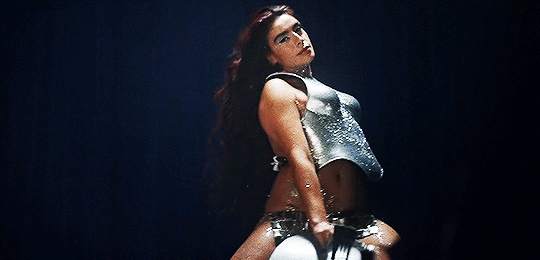
🐇 sevdaliza: jyeshta chandra
⛓because jyeshta is described as the “bad wife” and scorpio is associated with the dusthana house of obstacles (eighth house), we frequently see jyeshta natives personify their issues with love and self-perception in their songs. in the chorus of “girl like me” by alexa demie (jyeshta surya), she sings: i think i need a present, man. i’m just out here doin' the best i can. you think a girl like me gon' be single for long. your wrong. you think a girl like me gon' be trippin' for long. dead wrong. you think a girl like me, goddess like me, gon' be trippin', you'll see with a girl like me.”. demie’s song describes a woman who was once mistreated in her past relationships and learned to embody the natural goddess she is and not settle for the inadequacies of her past lovers. she learned from her sorrowful and toxic past relationships (like the goddess jyeshta) and recognized her worth (the evolved state of the eighth house). this is similar to the character alexa played in “euphoria”. she played a teen in a broken and abusive relationship who continuously kept perpetuating the cycle of inauspiciousness and eventually learned to step back and realize the amount of harm she has experienced. in the song, “ego death” (starring skrillex, possibly jyeshta chandra) we hear fka twigs (jyeshta chandra) sing: i let my ego down and then I rise back up. i let my ego down and then I'll be stronger. i’m armed, to let a sucker step up and get bombed. by a beat created by my producer, i am losin' my mind 'cause your heart's so blind. when you left me outside, i’d be losin' my mind. i am losin' my mind 'cause your heart's so blind. when you left me outside, i'd be losin' my mind. it’s gonna cost you to be great. you will have to sacrifice something to be great.”. again, we see the jyeshta native falling into the cycle of mistreatment and harm and learning her worth. she eventually grasps the concept of sacrifice and realization. she thrusts herself into the purifying abyss of scorpio and hopes to never turn back. recently, fka twigs came forward and discussed the abuse she faced at the hands of her ex partner. in a recent interview with “elle”, fka twigs strongly told her story to the reporter and spoke with passion and truth. in the song “human” by sevdaliza (jyeshta chandra), she sings “been in and out. and in front of my judgmental eyes, my precious disguise. business so cold. can’t cope with my own. how to not fail.”. in the entire song, sevdaliza realizes the cold disguise she once possessed, only to peel back the layers to find a mere human. a flawed being predestined for a life of more flaws. she finds artful peace in knowing this. in the music video for “human”, she is depicted as a temptress who lures men. she embodies the conscious choice of mastering buddha’s trickery. instead of breaking away from the cycle, sevdaliza finds enjoyment in inauspiciousness. this correlates to the dull state of the new moon.
☂ the umbrella is said to represent jyeshta. it is reflective of jyeshta’s state of reflecting what other’s project onto them. the full moon is associated with receptivity and harnessing light/energy. scorpio is the debilitation of chandra, as is cancer is the debilitation of kuja, because the energies of kuja and chandra oppose each other. kuja is rigid, hard, powerful, and tamasic. chandra is fluid, malleable, inward, and auspicious. with scorpio’s kuja rulership, we see jyeshtas acting cold and distant when they become used to harmful environments and develop the coping mechanism of allowing other’s energies to bounce off of them, much like how an umbrella protects you from the rain. rain is also symbolic of nourishment and bountiful energy, as it nourishes all the beings on this planet. this is why water is linked to feminine energy. in scorpio, a water sign, we see kuja blocking the receptivity associated with water and jyeshta bestowing this receptivity when it’s time. only when the jyeshta native distances themselves from a life of strife and never-ending cycles of abuse, may they learn to close their figurative umbrella and swim in the rain of multiple emotions and influences. an example of the symbolism of the umbrella is elle driver (played by jyeshta native daryl hannah) in “kill bill”. as she walks down the hospital hallway to kill the bride, she is adorned in a nurse costume and has an unopened red umbrella in her hand. the unopened umbrella represents her allowing the floodgates of outer influences to open. she no longer cares about her perception and is shown in her rawest form. she is no longer the illusionary and illusive character who hides in scorpio’s mystery. she is now revealed to be an evil cut throat being. the umbrella’s red color is symbolic of kuja and denotes her revealing her true tamasic nature and her carrying the collective blood of her enemies.

🐇 nicki minaj: jyeshta surya
🌩 the deity who rules the jyeshta nakshatra is indra. he is the deity of lightning, thunder, and rain. he is considered to be the king of all gods and heaven. indra rules the sky and and wields the power of rain as his weapon. he is also considered to be the god of battle. prior to each of his battles, he drank a vast amounts of soma. soma is a divine juice that strengthens him to accomplish his deeds in combat. it is he who defeated the serpent vritra who had swallowed all the waters of the world spurring a tumultuous drought. indra split the belly of the serpent with his thunderbolt, releasing the waters and generating life. by killing the serpent, indra separated land from ocean, and caused the sun to rise (this act of land separation is comparable to the god zeus and the christian god). indra slicing the belly of the serpent, recalls how jyeshtas must retire their umbrella to generate life in their lives. however, there is another item they will find to be particularly important during their journey in this lifetime.
🧿 every jyeshta i have ever met holds at least some significance for a form of the talisman. this is because jyeshta is also symbolized by the talisman/evil eye. this all correlates to jyeshta being the cosmic jewel, the shiny emerald who captivates their truest beauty. it’s green color honors the symbolism of buddha and is reminiscent of the blue or green evil eye. the concept of the evil eye exists in many cultures from hinduism to islam to turkey.
🔮 the overall concept of the talisman is called "apotropaic" (which is greek for "turns away"). talismans are believed to turn away or turn back harm, like an umbrella, bouncing off the influencing waters. disks or balls, consisting of concentric blue and white circles are generally representative of the evil eye in common talismans in west asia. however, this emblem is most commonly found in turkish cultures. this blue or green eye can also be found on some forms of the hamsa hand (which is also known to ward the evil eye of others). The word hamsa, also spelled as khamsa and hamesh, means "five" which refers to the fingers of the hand.
🤚🏽 in jewish culture, the hamsa is called the hand of miriam/mary and, in some muslim cultures, the “the hand of fatima” (fatima being the daughter of the prophet muhammad). it is primarily the muslims in the near east and mediterranean regions that believe envious looks can contain destructive power. the talismanic power of the nazar defends against this destructive energy. this is why the pure virgin mary or fatima is said to ward off these negative influences, recalling baglamukhi who was called to aid the other deities in the slaying of the demon.
🥚 the evil eye also heavily exists in hispanic and latinx cultures. it is referred to as the 'mal de ojo' and it is very prevalent in spanish culture throughout history. in most of mexico and central america, infants are considered at special risk for the mal de ojo and are often given an amulet bracelet as protection. this amulet bracelet typically contains an eye-like dot painted on the amulet. to also ward against the mal de ojo, it is customary to allow admirers to touch the infant or child. one popular traditional cure in my old hometown and in parts of central or south america involves a curandero (otherwise known as a folk healer). the curandero sweeps a raw chicken egg over the body of a victim to absorb the power of the person with the evil eye. once this is finished, the egg is later broken into a glass with water and placed under the bed of the patient near the head. it is usually checked immediately to see if the broken egg appears cooked. if this happens, it means that the patient did have the mal de ojo. after this ritual is completed, any pains or sickness from the mal de ojo is ceased. the concept of the egg is also closely linked to the bunny (jyeshta’s yoni) in some european cultures. most notably, the easter bunny.
🐰 easter is a religious holiday, but a great deal of its american customs are linked to pagan traditions. the egg itself is an ancient symbol of new life/re-birth. it has been associated with pagan festivals celebrating spring. many christians view easter eggs as a representation of jesus’ emergence from the tomb and resurrection. in orthodox christianity, it is traditional to have ‘the octave of easter’, essentially an eight day celebration of easter. during this celebration, the surya usually moves from revati (the final nakshatra) to ashwini (the first nakshatra). before i continue any further, i am not the first one to find this correlation, i believe the lovely @/shravishtamoo and @/365chimera were the first to talk about this on twitter. out of respect for not taking credit for their work, i will only lightly graze over this topic and solely share my opinion on this.
🌸 revati is under the vimshottari dasha rulership of buddha and the aries rashi of ashwini is ruled by kuja. kuja is overruled by bhumi, the cosmic mother or earth goddess. bhumi is usually depicted with four arms, holding a pomegranate, a water vessel, a bowl containing healing herbs, and another bowl containing vegetables. she is sometimes depicted with two hands, the right hand holding a blue lotus known as kumuda or utpala, the night lotus, while the left hand may be in the abhayamudra, this is a pose meant to mimic the tail of a horse. bhumi is symbolic of the cosmic flourishment. her pomegranate, healing herbs, and water vessel are symbolic of the fruitful tides and nature of the cosmic mother. much like how easter is linked to the pagan festival/celebration of the spring equinox (the day the surya enters into tropical aries). ashwini is the birth of the nakshatras, but bharani is considered to be the cosmic yoni. bhumi’s stance represents the horse ashwini and the cosmic egg. as bharani represents inward fertility, like the ripe pomegranate and cooling, feminine waters of the yoni. whereas, jyeshta, who is also ruled by kuja (rashi-wise), models this seemingly fertile abundance on the surface. like how the octave of easter combines the energy of buddha and kuja, we see this internal need to ascend their constant negativity, like how jesus died and arose from the death. jesus was betrayed and beaten brutally, similar to how many jyeshtas will find themselves continuously hurt by others. i understand this may sound redundant but look at the jyeshta goddess, baglamukhi, indra, tripura sundari, the octave of easter, and bhumi. they all required ascension, forgiveness or rebirth, which are necessary when such a tamasic planet like kuja and poltergeist-like spirit of buddha operate in their shadow state.
even bunny-like formations have been known to pop up on the planet mars itself: https://www.nasa.gov/mission_pages/mars/images/odyssey-image_feature_295.html

🐇 naomi campbell: jyeshta chandra
5️⃣ the number 5 is very important and reoccurring in the lives of jyeshta natives. the number five is said to be representative of buddha. as you have read through this post, you will notice the number five has reoccurred constantly. such as, tripura sundari’s five bows, the five-finger hamsa symbol, jyeshta natives like mick jagger and jay-z who are both life path 5s, and even some of the jyeshta names i have included in this thread total to the number five (such as, nicki/onika = 5 and tyra lynne banks = 14 = 1+4 = 5). because this number is symbolic of buddha, this number is said to denote intelligence, constant changes, and business success. however, the number five primarily shows a free-spirited and lucky nature. this is why the number sequence of five is said to be incredibly auspicious. i would like to focus on the fifth book of the bible: deuteronomy, a book filled with rebellion and imposing laws. a quote i think particularly describes jyeshta is deuteronomy 28-14: “If you fully obey the lord your god and carefully follow all his commands I give you today, the lord your god will set you high above all the nations on earth. all these blessings will come upon you and accompany you if you obey the lord your god: you will be blessed in the city and blessed in the country. the fruit of your womb will be blessed, and the crops of your land and the young of your livestock – the calves of your herds and the lambs of your flocks. your basket and your kneading trough will be blessed. you will be blessed when you come in and blessed when you go out. the lord will grant that the enemies who rise up against you will be defeated before you. they will come at you from one direction but flee from you in seven. the lord will send a blessing on your barns and on everything you put your hand to. the lord your god will bless you in the land he is giving you. the lord will establish you as his holy people, as he promised you on oath, if you keep the commands of the lord your god and walk in his ways. then all the peoples on earth will see that you are called by the name of the lord, and they will fear you. the lord will grant you abundant prosperity – in the fruit of your womb, the young of your livestock and the crops of your ground – in the land he swore to your forefathers to give you. the lord will open the heavens, the storehouse of his bounty, to send rain on your land in season and to bless all the work of your hands. you will lend to many nations but will borrow from none. the lord will make you the head, not the tail. if you pay attention to the commands of the lord your god that I give you this day and carefully follow them, you will always be at the top, never at the bottom. do not turn aside from any of the commands i give you today, to the right or to the left, following other gods and serving them.”. essentially, if you follow the teachings of your deity (operating in your light state), you will reap the bountiful crops of spiritual abundance and find freedom within (the theme of 5 in vedic teachings). the outer influences of others will no longer affect your inner being. jyeshta becomes the flowing waters of indra and bhumi, abundant in the freedom these natives onced crave. while jyeshtas appear to have an abundance of freedom, as they continuously bounce from one situation to another, it is insincere if they do not learn how to alter their surroundings, set boundaries, and learn to love again, reminiscent of the number four.
4️⃣ another number jyeshtas see quite frequently is the number four. the number four is said to be ruled by rahu, the head of the serpent god. recall in the aforementioned bible quote, “the lord will make you the head, not the tail”. this is the essence of the number four. it symbolizes the need for/ability of staying grounded, stability, worldly achievements, and secrecy. buddha was said to be one of the only deities to tame rahu. when a number of the nature of four occurs in a jyeshta’s life, it means the native must learn to tame their inner being and focus on staying grounded and not share their accomplishments with others. as discussed previously, buddha-ruled natives struggle with the immense power of their tongues. because they are able to have their words believed by the masses, if they say they will do something and it does not happen it brings a great deal of distrust around them. the art of secrecy is said to be something rahu thrives in, due to his natural illusionary background. embracing the illusion will help them ward the evil eye, with or without an amulet or talisman. if these natives do not share their plans or accomplishments, others cannot impose their hatred or jealousy against that native.
9️⃣ it is interesting to note that once the number of freedom (5) and secrecy/achievements (4) come together, they make 9. nine is the number representative of kuja. nine denotes strength, leadership, knowledge, and fire. it is a number described as “a man who walks with the torch of intelligence [buddha], in a road full of blood stains [kuja], not seeing the snake below his feet [rahu].”. modeling the fiery and strong spirit of indra, slaying great beasts in battle, much like how the owl is one of the only animals to beat the snake into submission (rahu).

🐇 mädchen amick: jyeshta surya
🦉 recall from the earlier paragraphs, jyeshta is considered to be linked to the goddess lakshmi (the sister of jysheta’s comparative goddess: alakshmi). lakshmi is depicted as sitting on an owl. this owl is why jyeshta is associated with the supernatural owl. owls are said to symbolize knowledge, wisdom, and dread. the owl is also closely linked to the dawn of death and misery. the differences of the spiritual associations of the owl is symbolic of the axis of jyeshta/alakshmi and lakshmi. due to their rare and majestic nature, many cultural myths associate owls with the presence of a higher being, such as guardians, spiritual guides, and vahanas. their ominous hoot is an anamnesis of being lost in a dark forest reeking of danger and the scent of pine. the owl may either be your beacon of light, carrying the auspicious powers of lakshmi into your life, or bringing detrimental, loss and death to your dearest beloved.
🐦 the name of lakshmi’s vahana owl is known as uluka. uluka is considered to be another name for lord indra (the deity ruling jyeshta). the combination of the goddess of wealth (lakshmi) and the king of heaven (indra) personifies the auspicious, wealthy, and powerful spirit linked to the owl. because the owl dwells in the night, it is also a symbol of the darkness of ignorance (avidya). the owl’s aversion towards the daytime is indicative of turning away from the solar path to embrace the feminine forestry of the night. the is why lakshmi is said to guide one to open the eyes to the light of wisdom residing within themselves. she is said to guide you to the goddess saraswati, who is said to rule our knowledge, alphabet, and the tongue (recall jyeshtas penchant for the tongue). uluka becomes lakshmi’s vahana when she blesses wealth and prosperity. the owl asks of lakshmi’s devotees to not be trapped by the illusions of wealth (444), warning against the dangers of arrogance and stressing discipline. when her wealth is used by humans for inauspicious activities, one is said to be blinded, like owl who can longer tolerate the bright rays of surya. it is then uluka embraces the antithesis of the axis and becomes a bird of ill omen flying the goddess of alakshmi around to your door-step, bringing darkness, disgrace, inauspiciousness and misfortune.
🏔 the show “twin peaks” is heavily influenced by the jyeshta nakshatra, as approximately 25% of it’s cast and four directors have prominent jyeshta placements (surya, chandra, lagna, or atmakarala). it centers around a small logging town filled with murder. in this show, nothing is as it seems, intuition is valued, and your dreams guide you. a common phrase in the show is: “the owls are not what they seem”. in the show, there appears to be two paranormal realms, the black lodge and the white lodge. these realms correlate to the lodge spirits, who are unable have physical bodies. because of this, they are limited in the ways they can travel outside the lodges and usually require a host/vessel. while other spirits exist in various mediums, like wood, electricity, and running water.
⛰ the owls are said to be a physical medium of the watchful eyes of the lodge spirits. the owls are theorized to control the entire narrative of the story, invoking harm or bliss. they serve as a barrier and channel between the illusionary twin peaks and the deeply uneasy spiritual lodge realms. in the show, they literally serve as a mask to cover the face of a harmful spirit. thus, the owls are not what they seem. they may channel the deity they please and bring the essence of lakshmi or alakshmi to your door.
♟the owls are reminiscent of the nature of scorpio. scorpio is representative of the eighth house of the zodiac. with kuja being it’s rashi lord, we see a strong amount of strength, energy, achievements and inheritance in the lives of these natives. because scorpio is the watery dusthana, they have a strong intuitive nature when they let their guard down. in twin peaks, you will see many characters try to appear strong when, in reality, they are some of the weakest and sensitive characters in the whole show. an example of this is shelly (played by jyeshta native mädchen amick). shelly married an abusive man who expected her to only do domestic chores and be subservient. she tries to appear fine and cover the bruises to protect her other lover, but quickly her illusion is shattered. she becomes lost and scared, only to regain her confidence via her other partner. another possible jyeshta co-star, kimmy robertson (who played lucy), struggles with handling her romantic endeavors and is quite stubborn. once she feels she has met the right partner, her stubborn nature corrodes like a boulder chipping away from a cliff, only to reveal a sweet, pleasant waterfall of love. due to the scorpio rashi’s strong intuition, they generally have fixed ideas and tend to relentlessly follow them out of faith in their perception of the unknown. the deputy chief (played by jyeshta buddha atmakaraka native michael horse) is known for following his intuition and, due to this, he eventually ends up saving the lives of many others. scorpios also tend to value a small, close-knit friend group. we see the small town of twin peaks frequently coming together to help each other in need.
🌟 the eighth house is associated with the unveiling of deep secrets. this is why scorpios feel the immense need to get to the state of raw purity (the cosmic egg) to examine the situation in it’s purest form. throughout the entire series, mysteries are repeatedly being discovered and solved. however, these mysteries do not solely require the analytical mind. they also require the help and guidance of outside and unexplainable sources. in order to solve these mysteries, you must channel the nature of the owl to evaluate both sides. the eighth house/scorpio is also said to rule the genitals, whereas, kuja is said to heavily influence the sexual organs. in the entire show, sexual pursuits, pr*stitution, and kundalini energy is rampant. sexual energy abundance and accumulation is the cause of adoration. this is why we see jyeshta natives, like the fictional character holli would, nicki minaj, or fka twigs, exciting the sexual passion within others and enticing the masses with their trickster nature. you will often notice many jyeshta (and other buddha/kuja natives) natives create a great deal of sexualized content to express their untamable and playful skill. they embody indra in combat and wield their bodies like a cosmic sword, exciting the virility in others with their sharp nature. however, jyeshta natives do not care for pleasing the average partner, they wish to dominate them with their seemingly submissive nature. they thrive in an environment of underestimation and want you to assume they are a surreal illusion. much like the ashlesha nakshatra, jyeshtas are either tamed or dominated, but—more frequently—they are the one’s to dominate, as many people do not know to handle such icy, hot energy and are simply in mere awe of their beauty. this issue with knowing how to work along with jyeshtas and rise to their level is something many people struggle with. instead of wishing to see the jyeshta flourish and glow with passion, they will try to drag them down to their own low vibrational level, reminding jyeshtas of their original gandanta point of sorrow.

🐇 princess nokia: jyeshta chandra
💧water and, thus, the color blue holds great power in the lives of jyeshta. the jyeshta goddess herself was adorned with blue-black garments and is said to hold a blue lotus in her right hand. the color blue is said to be associated with shani and the lotus is representative of the vimshottari evolution of shani. the many shades of blue are reminiscent of the azure of a clear sky. shani is the planet of hard work, determination, and respect. if you honor shani, you will likely be at the zenith of life. shani is debilitated in the bharani nakshatra (representative of the famale yoni). bhumi is said to mount the elephant and jyeshta’s nature is often compared to the elephant (the yoni of bharani). we see water personifying their internal struggle of diligence and sexuality. the element of water itself flows and crashes with it’s feminine luster. it denotes cleansing, rebirth, and vital energy. the practice of swimming and watery movement is said to excite the feminine spirit and remove all negative energies that encompass the individual. think of how you take a refreshing bath or wash your face. the act of cleansing and the alignment with the water element is energizing and refreshing. recall the christian practice of baptism. baptism is said to be a christian rite of admission. it uses the rejuvenating power of sprinkling, pouring, or entrenching the devotee with water to wash away their sins. this behavior parallels to the churning of the cosmic ocean to produce the elixir of youth, as christians believe baptism saves the youth/innocence of your soul.
🌿 jyeshtas are often forced to grow up quite early in their lives. the often harsh and toxic environments they are surrounded by do not yield a balanced and cleansed individual. it is destined for them to put on a mask or illusion cope with this (recall the demonic spirit who used the owl mask in “twin peaks”). it allows them to feel protected, as how harnessing their sexuality brings them great power. but deep down, they are innocent and youthful spirits. paralleling the goddesses jyeshta and alakshmi who lived lives of great strife but had a kind soul. their aversions to auspiciousness is something they could not control. it was their destiny. the life of jyeshtas are said to be incredibly karmic and destined. they cannot control the terrible and harsh energies of those who may come and go in their lives, but they can choose to walk through the smoky abyss or deep, cleansing waters to see if there is light on the other side of life.

🐇 brigitte bardot (left): jyeshta lagna
🐇 jane birkin (right): jyeshta surya
🚬 it is not uncommon to see jyeshta natives enjoying a good cigarette or cigar. as i once discussed in my magha exploration, natives of the gandanta points enjoy the symbolism and release smoke brings. this is because gandanta points are where the water and fire elements meet and cross. water is symbolic of the divine feminine (4H, 8H, 12H) and fire is symbolic of the divine masculine (1H, 5H, 9H). these elements are complete opposites. when water and fire collide, the water subdues the fire and we are only left with smoke. in the song “smoke on water” by deep purple (who has five members with prominent jyeshta placements), we see the nature of this smoky elemental intermingling under the co-rulership of ketu. the promiscuity of water and purification of fire combines and forms the infinite knot. ketu is the south node, representing our past lives and karma. whereas, buddha is the planet of awakening the discriminating intellect between benefic and malefic actions, essentially good and evil. the harsh, polar forces of water and fire (rashi elements) coupled with past lives and karma (ketu) and knowledge (buddha), create this need for escapism. the need for stimulation to calm the ever-present sense of anxiety or physical ailments gandanta natives are prone to. the use of cigars, cigarettes, or cylinder-shaped products of other smoky varieties (🌿) as a way to ease their anxious nature. as the dusthana houses are uneasy, ketu is unstable, and buddha plays tricks on the mind.
🌫 the cylinder shape of these smoky, stress-relieving products is symbolic of yang energy (the phallus). while this may sound odd, the intoxicating (yin) energy of tobacco and the yang shape of these products creates the perfect balance of water and fire to attract these natives. this is reminiscent of the nineveh cylinder. this cylinder is designed to be a message to the universal one and directs the eyes are set upon it. it is only the eyes that contain an energetic consciousness who will be able to understand the cylinder’s message. you must be able to feel and think to be integrated into the powers of the cylinder and hence the have the power to ascend. one’s energetic signature then changes and only then may the individual have the ability to receive it’s messages or symbols. this acts as a cosmic safety valve to prevent the duality of the lower dimensional worlds from contaminating the higher dimensions that reside in cosmic unity (indra). it represents achieving the human ability to go within your self and untie the knot/noose of tripura sundari within to balance one’s intention, focus and willpower. the symbol of latter is an upward or downward pointed triangle. this triangular figure is symbolic of completion, the three worlds tripura sundari transcends. the journey for jyeshtas is long and hard, filled with fire and water, smoke and mirrors, and lightness and darkness. the cylinder of nineveh invites jyeshtas to walk through the smoky abyss, through the yang passage of the cylinder to untie their inner knot of restriction to be finally free from the harsh realities of this world.

🐇 ‘holli would’ as played by jyeshta surya kim basinger in “cool world”
💋 as always, i am open to any constructive criticism! i tried to touch on the deities’ involvement in the appearances, manifestations, and symbolism of jyeshta. to be quite frank, studying the story of jyeshta brought me to tears. it’s unfair the amount of harm and difficulty they experience in their lifetimes, but their determination and wit pulls them through. studying these many deities, symbolism, cultures, and religions for this post has been so honoring and humbling. as i was making this post, a bunny approached my window and i do not live in an area where rabbits are common. i just thought that was a lovely sign, i’d be a fool to think this is merely a coincidence. if you are looking for more information about jyeshta, get to know the overrulers and supreme deities of kuja, bhumi (the earth goddess) and skanda (the war god), and buddha, vishnu (the maintainer) and narayana (the cosmic person). also—and i cannot stress this enough—familiarize yourself with the deity of this nakshatra: indra. if any of my placements or information are incorrect please feel free to let me know! also, i am fully aware of the origins of vedic astrology and if i was in anyway disrespectful to hindu culture, i will take down this post immediately. i am incredibly honored to know such lovely vedic astrology enthusiasts. you all mean so much to me xx
**all of these placements were found using astrotheme/.com and/or astro-charts/.com. it is important to note that some chandra (moon) placements may be off by up to 6 degrees and lagnas (risings) as well, due to the fact that many websites do not have 100% accurate birth times for the given celebrities.
**i take absolutely no credit for the invention of vedic astrology-based appearance profiles. please watch claire nakti on youtube or look into @/cn0bles, @/lovejustlied, @/dh4nishta, and @/vanillemercure on twitter for more in-depth analysis on vedic astrology xx
#vedicastrology#astrology#moon#nakshatras#budha#rahu ketu#mercury planet#scorpio#scorpio aesthetic#scorpio moon#jyestha#mars planet
653 notes
·
View notes
Photo
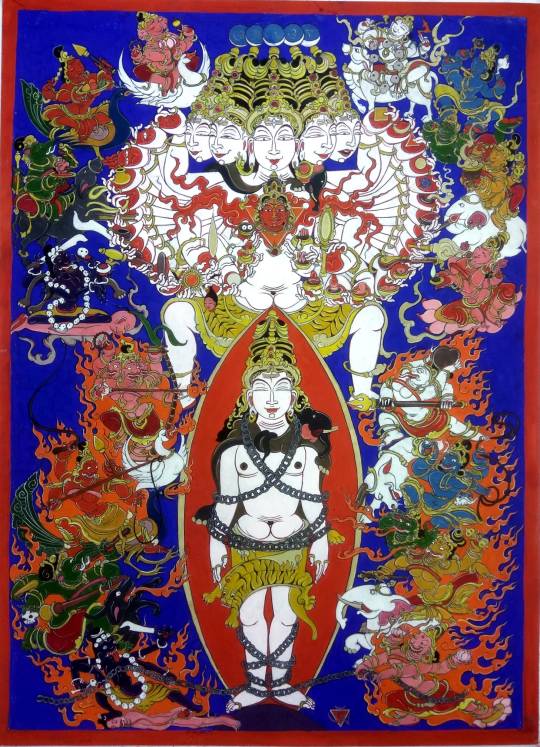
Shivoham painting and text by Arghya Dipta, Bengal
This painting draws its subject from the non dualistic philosophy of the Shaiva and Shakta Agamas where the individual being (जीव) is none other than Shiva himself in its true essence. Owing to the play of Shiva’s power of Absolute Freedom ( स्वातन्त्र्य), his infinite Consciousness voluntarily contracts into a finite being or Purusha who is verily an Anu (अणु) or tiny unit. To effect the creation of the dualistic universe, he himself reduces his omniscience, omnipotence and omnipresence to a limited state of knowledge, power and presence. However, even in this limited state, his power of infinite consciousness is not exhausted as it only remains in a latent condition. This is to say that every single individual in the universe, being Shiva himself, houses the totality of the cosmic energy, though s/he is him/herself unaware of it. The spiritual discipline of Tantra aims at the gradual unfolding of this infinte energy latent in our psycho-physical constitution. It is not through the rejection of the body and the material world but a proper harnessing of their vast reservoir of power that this Yoga is possible which aims at the complete integration of consciousness, mind, energy and matter.This is to say that unlike as in the monistic Vedantic system, the Absolute in the Tantras is not a static inert being but is vested with a vibrantly dynamic energy. The entire play of involution and evolution centres round this core essence dynamism in Shiva’s being, which in the Shaiva doctrines of Kashmir is variously identified as Chiti, Shakti, Vimarsha, Vak, Spanda, Satta, Sara, Sphuratta. Being such, it is the very pulsating heart of Shiva.सा स्फुरत्ता महासत्ता देशकालविशोषिणी।सैषा सारतया चोक्ता हृदयं परमेष्ठिनः।।She is the inherent principle of Pulsation (sphuratta), the great Existence (mahasatta) which is beyond time and space. Being the core essence of Shiva, the Supreme Lord, She is known to be His very beating Heart.Being the sole ground of Shiva’s existence, this Shakti and Shiva are absolutely identical. As the Spanda school of Kashmir Shaiva explains, when the pulsation of this dynamic consciousness occurs in a state of equilibrium, Shiva seems to be in a condition of stillness. In other words, even when the Absolute seems to be motionless or purely transcendental, he is never bereft of the dynamism of Shakti since Shakti Is his very self. However in creation, the one universal Shakti displays multiple modes which evolve into grosser forms through the four stages of speech, since it is as Speech or Vac (वाक) that the dynamism of Shakti operates. In course of this evolution the entire scheme of fifty one letters from A(अ) to Ha (ह) is produced that are grouped under the eight Varga Matrikas.1. Brahmi- the Ka-Group (कवर्ग) presiding over the letters क ख ग घ ङ2. Maheshvari- the Cha-Group (चवर्ग) presiding over च छ ज झ ञ3. Kaumari- the Ta-Group (टवर्ग), presiding over ट ठ ड ढ ण4. Vaishnavi - the Ta-Group (तवर्ग) presiding over त थ द ध न5. Varahi- the Pa-Group (पवर्ग) presiding over प फ ब भ म6. Aindri -the Ya-Group (यवर्ग) presiding over य र ल व7. Chamunda - the Sha-Group (शवर्ग ) presiding over श स ष ह8. Mahalakshmi - the Avarga (अवर्ग), from अ to अःWhat was referred to earlier as the process of Shiva’s playful self-finitization into the individual self, is actually effected by the emergence of these eight modes of Shakti into grosser forms. As subtle Speech solidifies into gross matter, these macrocosmic goddesses assume the form of the basic crude instincts that dominate the microcosmic Shiva or the individual being. Brahmi becomes lust (काम), Maheshvari anger (क्रोध), Kaumari greed (लोभ), Vaishnavi attachment (मोह), Varahi ego (मद), Aindri jealousy (मात्सर्य), Chamunda sin (पाप) and Lakshmi virtue (पुण्य), all of which keep Him bound within the cycle of phenomenal existence. Every moment they torment him and drive his Karmic courses so that he is reduced to an enslaved Pashu. However, with proper spiritual discipline, the limited Anu rises to realise the true nature of these Matrikas and they take an inward and subjective turn and metamorphose into modes of his inner power of unlimited Freedom (स्वातन्त्र्य). It is then that these very negative impulses transform into higher cosmic powers that participate in the infinite play of creation. All the Matrikas then seem to serve the Supreme Shakti or Shiva’s Heart with their respective functions in her play.Brahmi or Lust is realised to be a mode of Srishti-Shakti or that very power which is responsible for giving birth to the universe. Maheshvari or Anger is none other than Samhara-Shakti or the power that destroys the universes after each periodic cyclic course. Similarly Kaumari or Greed is the power that desires to manifest the multiplicity of the universe. Vaishnavi or Attachment is the power called Sthiti-Shakti since attachment to the world is alone responsible for the sustainance of it. . Varahi or Ego holds erect the sense of Individuality, Aindri causes various actions and reactions in creatures to drive the world motion. Chamunda and Laxmi as Paapa and Punya are the two poles of this world cycle.In this painting, the two columns display the two states of Shiva. The lower column has at its centre a figure of Shiva held in heavy chains as he is but the microcosmic Shiva reduced to a finite self perpetually being tortured by the Matrikas. Brahmi as Lust is constantly hitting him with the sugarcane bow and flower arrows of Kamadeva, Maheshvari in her destructive fury is hurling a huge stone at him. KaumarI or Greed has in her hands a fishing hook that tempts the Pashus only to embrace misery and sufferings at the end. Vaishnavi as Moha ties him with her noose. Varahi with her club beats him down to a tiny being. Aindri or Jealousy burns him within. Chamunda and Laxmi as Paapa and Punya stretch the chains that bind him to entangle him more and more into this bondage.However in the upper column, the same Shiva, with the shackle broken has regained his supreme awareness of himself as the eternally free Lord who has all his five powers of Cit, Ananda, Iccha, Jnana and Kriya fully unfolded and represented by his five faces whose expressions verily correspond to the functions of these powers. In his thirty six hands he holds emblems representing the thirty six elements that constitute the universe. 1. A lamp: Prakasha or the Shivatattva2. A mirror: Vimarsha or the Shaktitattva3. A closed eye: the Sadashiva Tattva with the objective universe concealed in subjective awareness4. An open eye: the Ishvara Tattva with the objective universe patent in its subjective awareness.5. Two eyes: the Shuddhavidya or the predominance of both subjectivity and objectivity.6. A pot: Maya or that which gives an objective form to the formless self separating it from itself as a ‘This’ or ‘Idam’ to be perceived externally7. A noose: Raga8. A book: Vidya or limited knowledge9. A tiny bowl: Kalaa or limited capacity10. A sword: Kaala or time, that which severs11. A goad: Niyati12. A phallus: Purusha or the Self-unit13. A triangular female genital: Prakriti or the three Gunas14. The Sun: Mahattattva15. A head: Ego16. The moon: Mind17. Nose18. Tongue19. Eyes20. Fingers: Skin that touches21. Ears22. The speaking organs23. Hand24. Leg25. Anus26. Sexual organs27. A veena: sound28. A chamara : Touch29. A brush: Form30. A cup of wine: taste31. Incense: smell32. A hexagon: Space33. A circle: Wind34. A triangle: Fire35. A crescent: Water36. A square: EarthAll has been possible because of the realization of the Great Heart of Shiva, his Shakti whose divine pulsation has caused the integration of the whole universe into his being. The eight Matrikas serve her with their respective gifts. Brahmi with the flower of creation, Maheshvari with the remains of dissolution, Kaumari offers her the juicy fruits that tempt all creatures, Vaishnavi with the music of her flute of world enchantment, Varahi nourishes the individual ego only to be sacrificed to her at the end. A fragrant incense rises from fire of jealousy that Aindri burns. Chamunda offers all vices as a pass time drink and all virtues are served as a lamp by Lakshmi.
118 notes
·
View notes
Link


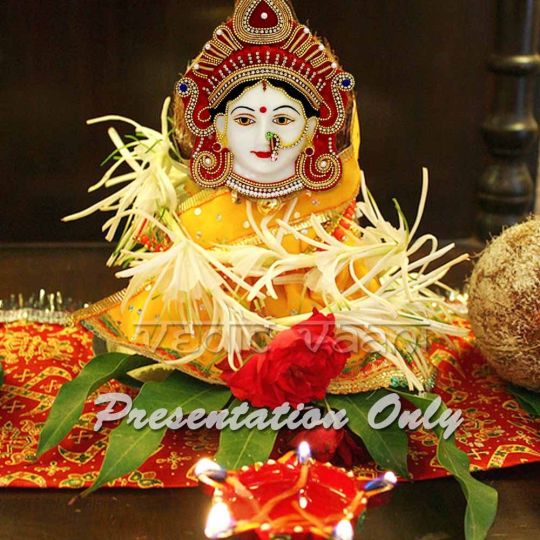
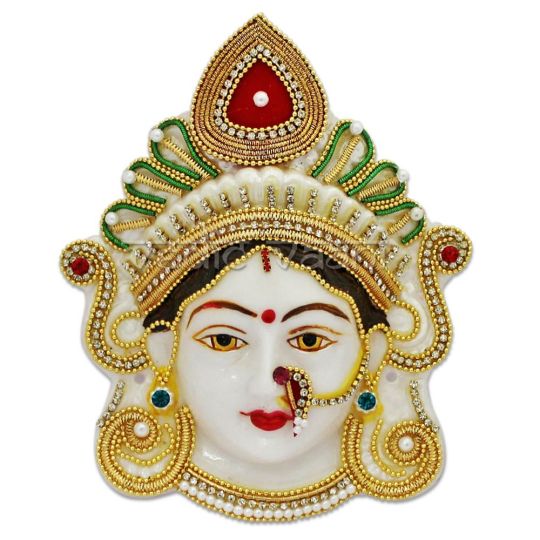

Mahalakshmi is the Hindu Goddess of wealth, prosperity (both material and spiritual), fortune, fertility and the embodiment of beauty. She is said to bring good luck and is believed to protect her devotees from all kinds of misery and money-related sorrows. She is also the personification of the spiritual fulfillment. Mahalakshmi face can be placed in your house/office to bring prosperity or can be gifted to your loved ones.
Design: Made of poly fiber. Colours: Red, Yellow, White Dimension: 6 inches (H) x 4.75 inches(W) Weight: 90 grams approx
Visit Us On: https://www.vedicvaani.com/maha-lakshmi-devi-face Call Us : +91-9820697944 Email: [email protected]
#Mahalakshmi#mhalakshmivratham#goddesslakshmi#ammavari#goldfinish#devi#gold#finishing#poyfiber#design#decoration#festival#poojaface#deviface#mukuta#face#god#goddess#lakshmi#estore#shoponline#maharashtra#vedicvaani#india#vedic#vaani
0 notes
Text
Natural 13 Mukhi Nepali Rudraksha
Natural 13 Mukhi Nepali Rudraksha


₹7,500.00
Natural 13 Mukhi Nepali Rudraksha (13 faced Rudraksh) also called Trayodash Rudraksh represents Lord Indra, the King of Devas, and God of rain and thunder. It is a symbol of abundance, prosperity and happiness. This holy Rudraksh is blessed by Lord Kamdeva (God of love and attraction) and Goddess Mahalakshmi. The ruling planet is Venus which is associated with wealth and worldly possessions. With their blessings the wearer can fulfill all his desires and lead a harmonious happy life.
The benefits of 13 Mukhi Rudraksh (Terah mukhi Rudraksh) are manifold. This Rudraksh is also called “Indra Rudraksh” due to its association with Lord Indra. The blessings and protection of Indra Devta is gained by the wearer. The bead enhances the will power, confidence and the determination of the user.
Lord Kamdeva (Cupid god) blesses the wearer of 13 Mukhi Rudraksh by fulfilling all his worldly desires. The wearer is bestowed with success in love life and intimate relationships. It helps to enhance the creativity and passion inside him. The bead assists in fostering love connection, finding a suitable partner, and building a harmonious relationship. It bestows the user with the charm and attractiveness of Kamdev (Cupid god).
Terah Mukhi is blessed by Goddess Laxmiji which provides wealth, riches and prosperity to its user. By reciting the Laxmi Sukti or Mahalaxmi Strot one can achieve immeasurable profits.
Astrologically, the original Natural 13 Mukhi Nepali Rudraksha nullifies the negative effects of planet Venus and Moon.
Medicinally, this Rudraksh helps in the treatment of sexual disorders, low desire and infertility. It improves the functioning of urinary and reproductive organs. Also the bead is helpful in curing lower back pain, sciatica, and kidney related problems.
How to wear : As regards wearing the holy Rudraksh, it can be worn as a pendant around the neck or as a wrist bracelet. This can be worn in silk or cotton thread, and with a capping of gold, silver or ashtdhatu (an alloy comprising eight metals).
Method of wearing: 13 Mukhi Rudraksh is worn on any auspicious day such as Monday, Full Moon Day or a festival related to Lord Kamdev or Goddess Lakshmi. After taking a bath, clean the holy bead raw cow milk, Panchamrit (a mixture of milk, curd, honey, ghee and sugar). There after clean with Gangajal or any other holy water and put on a copper plate at the place of worship. After chanting the mantra “Om Hreem Namah” at least 108 times, wear the Rudraksha.
Administrators, Actors, Politicians, Leaders and Stage Artists are advised to wear this Rudraksh to attain success in their fields. Since Lord Indra is called the King of gods, the wearer is blessed by all other gods as well.
Buy 13 Mukhi Rudraksha From Nepal,
13 Mukhi Premium Rudraksha (Nepali Bead),
Natural 13 Mukhi Rudraksha (Nepal Origin- Collector Size),
What is the benefit of 13 Mukhi Rudraksha Nepali?
Who can wear 13 mukhi Rudraksha?
Is 13 Mukhi Rudraksha rare?
13 मुखी रुद्राक्ष कौन पहन सकता है?
13 Mukhi Rudraksha benefits,
13 Mukhi Rudraksha Nepali,
13 Mukhi Rudraksha price in India,
13 Mukhi Rudraksha Mala price,
13 Mukhi Rudraksha side effects,
13 Mukhi Rudraksha benefits in hindi,
13 Mukhi Rudraksha Bracelet,
13 Mukhi Indonesian Rudraksha,
222, Agarwal tower, I.P.Extension, Patparganj, Delhi, 110092
Contact no : 7042891757
0 notes